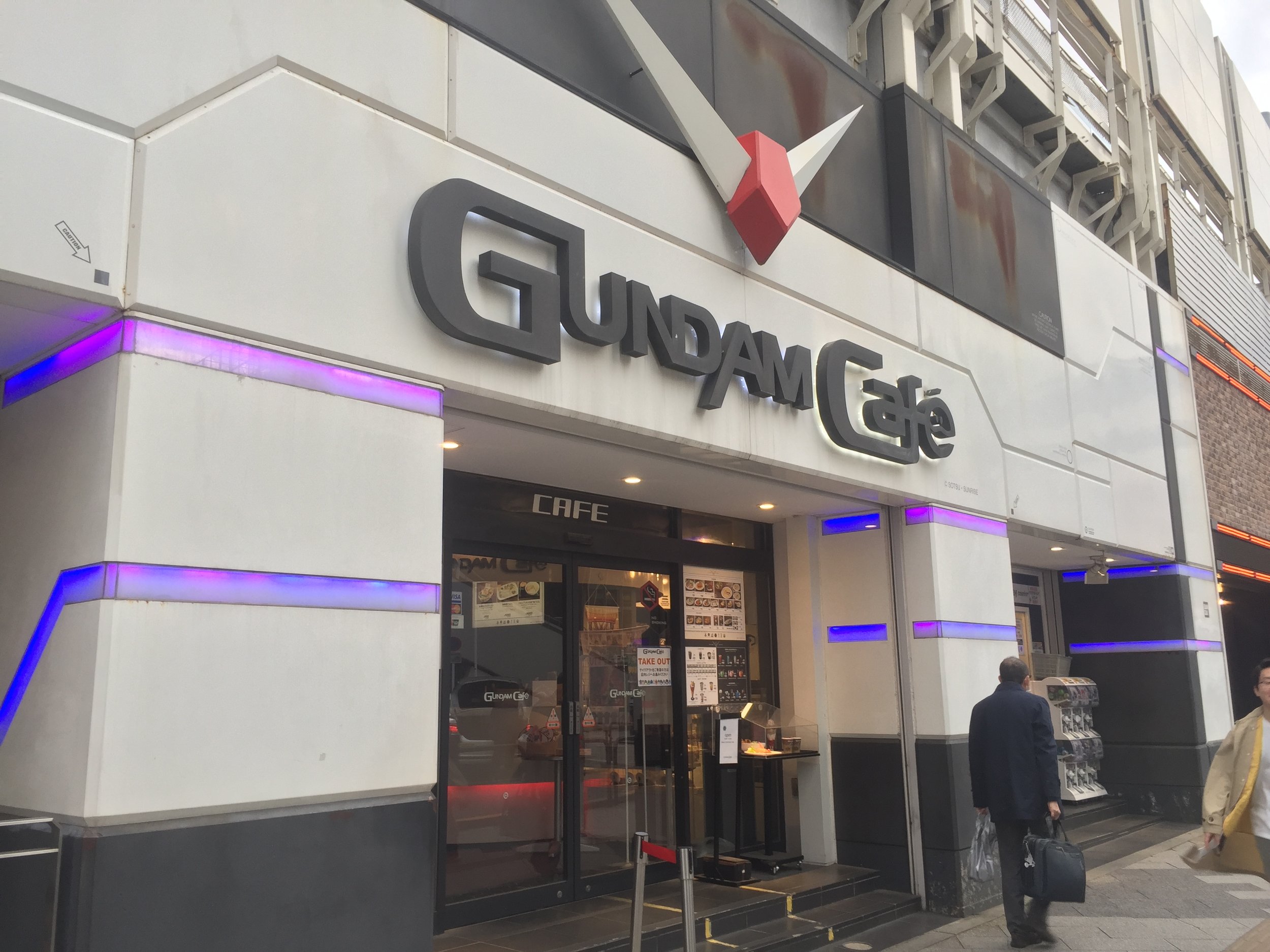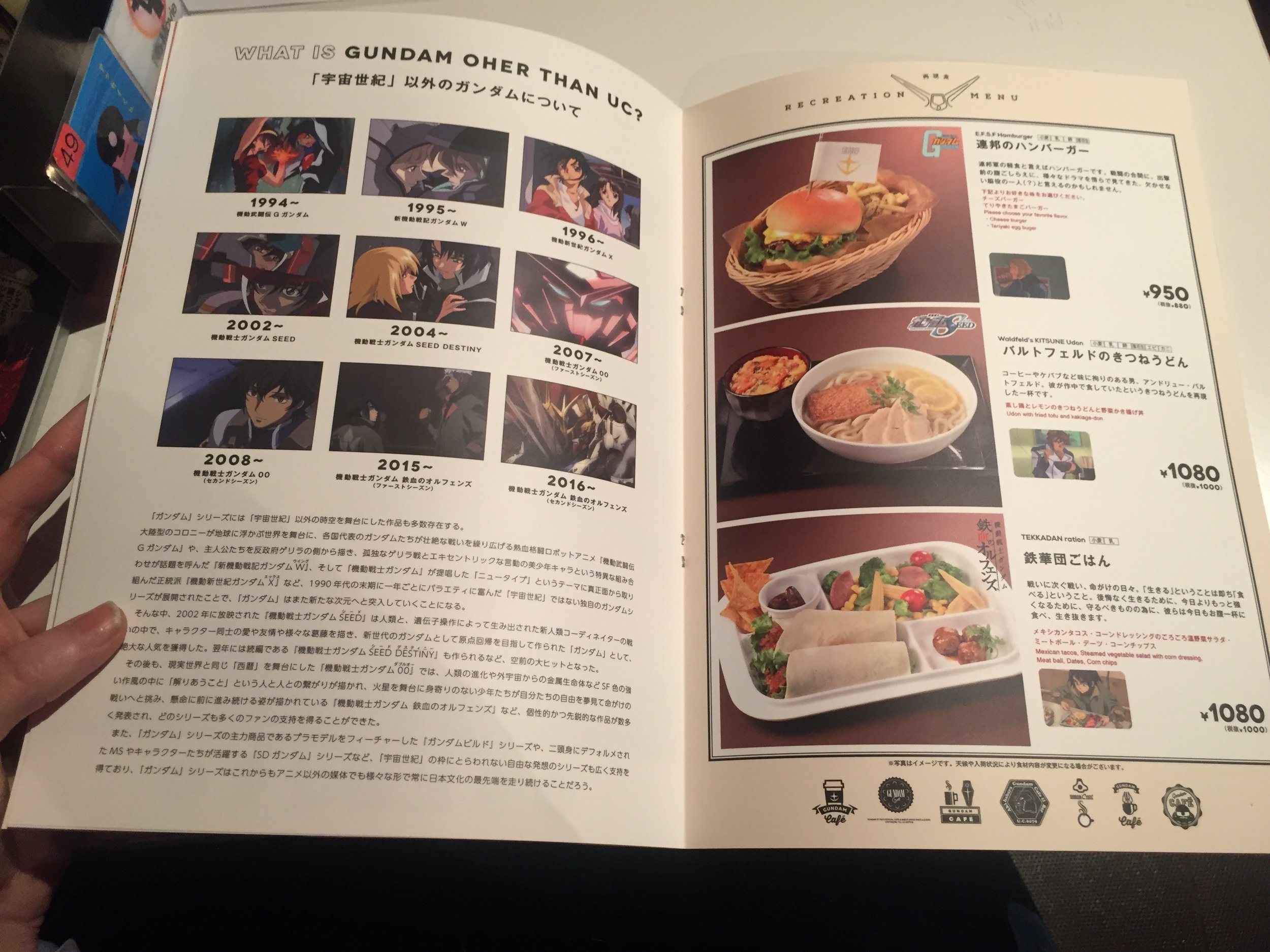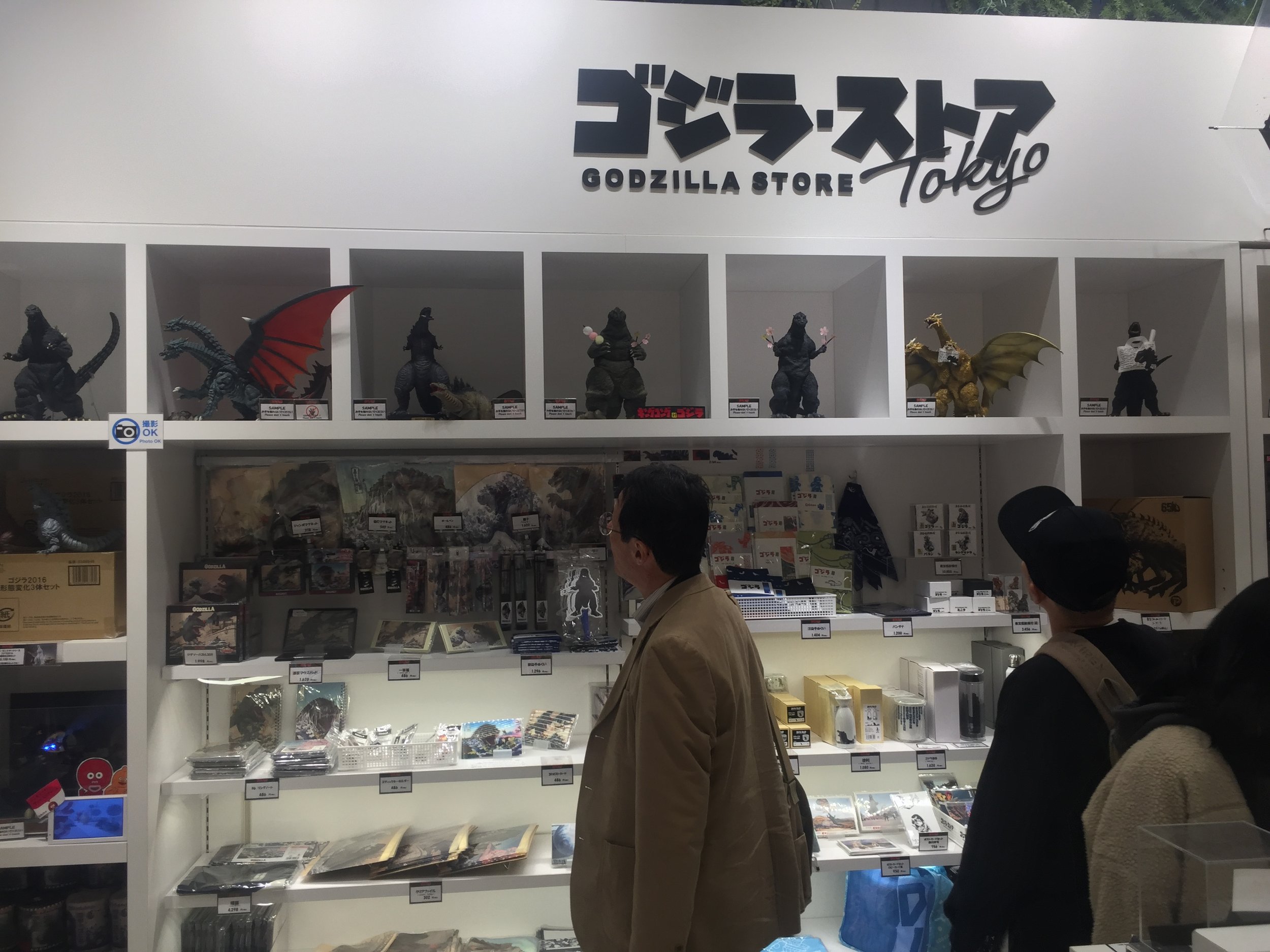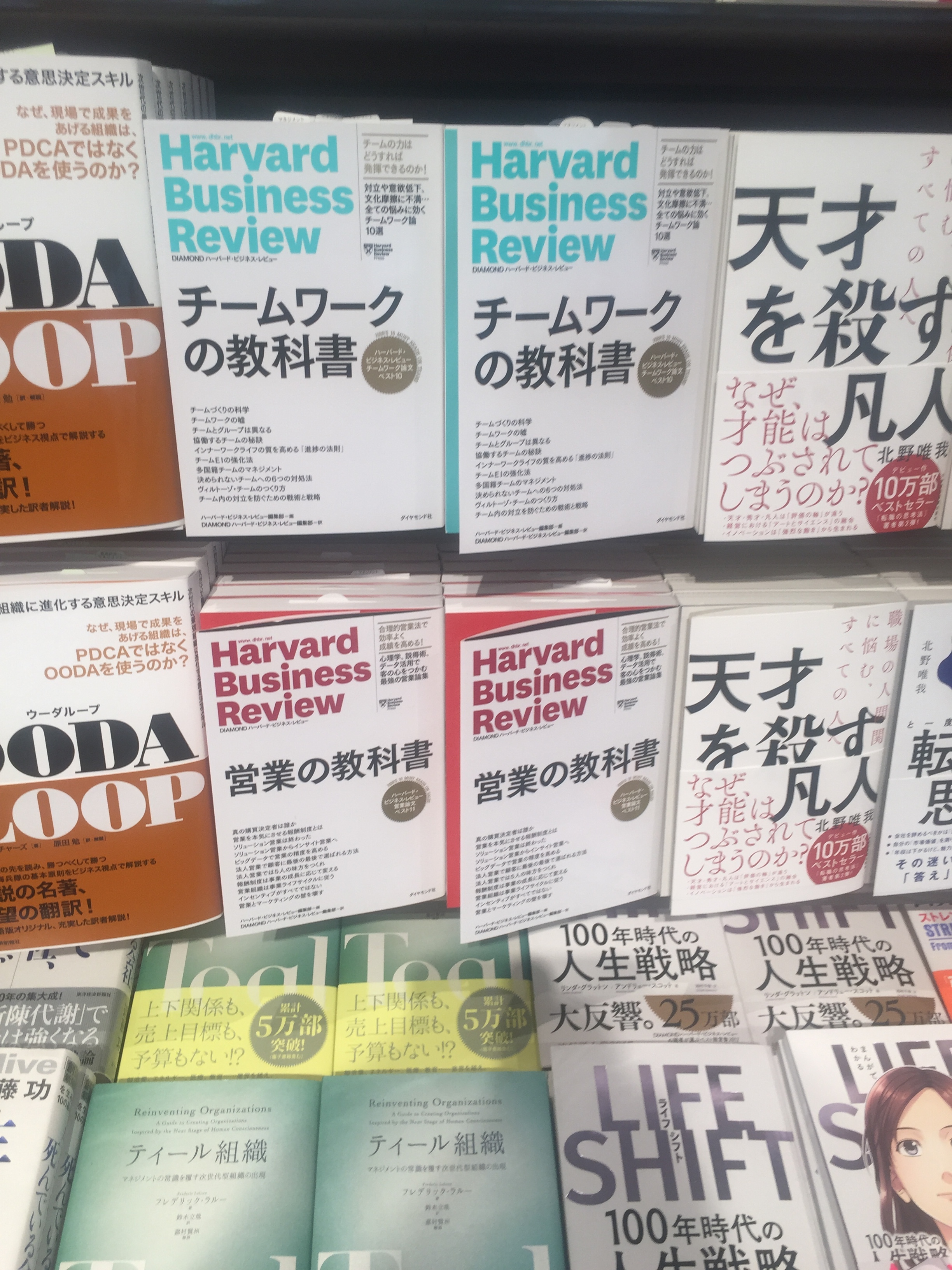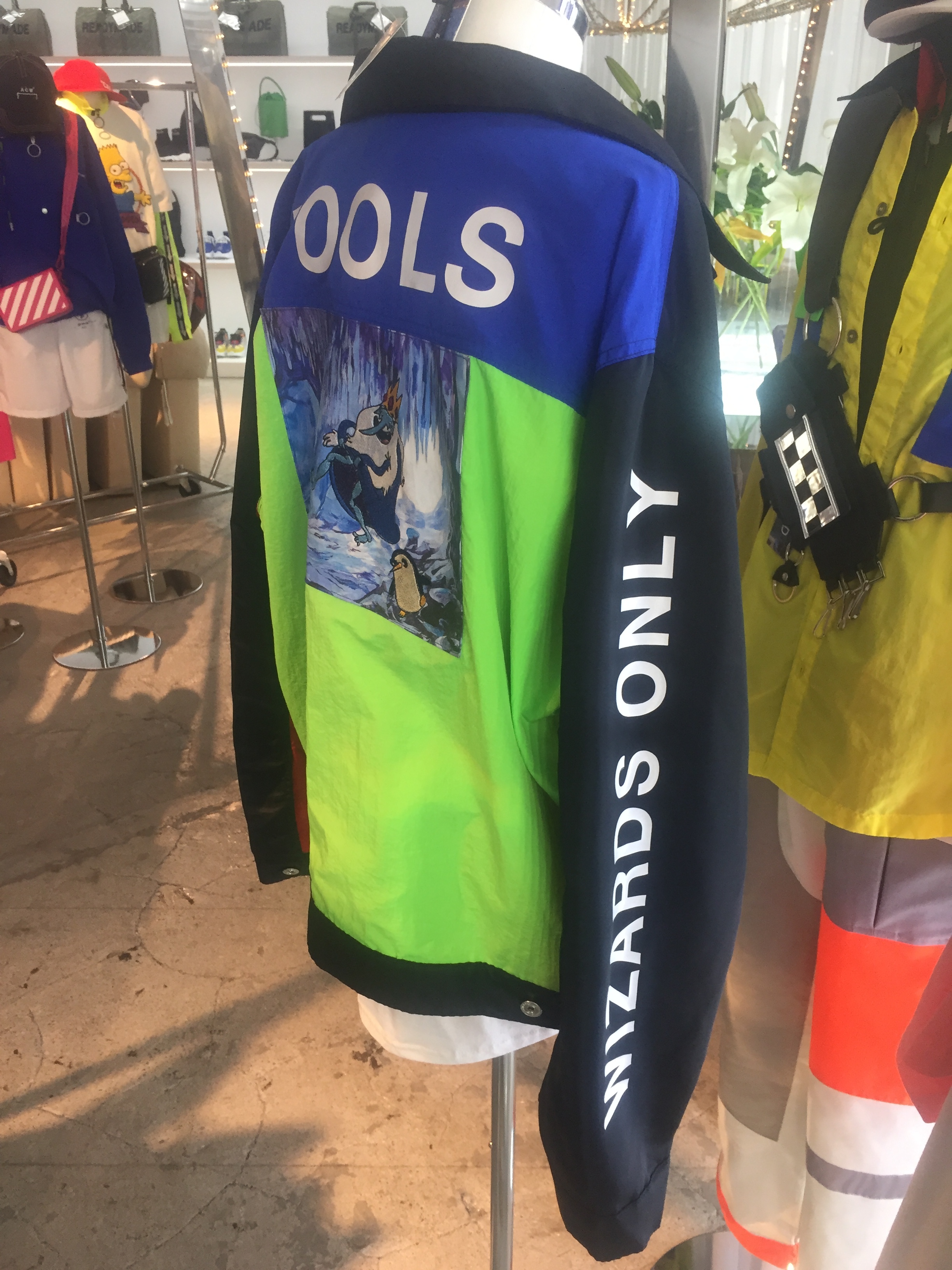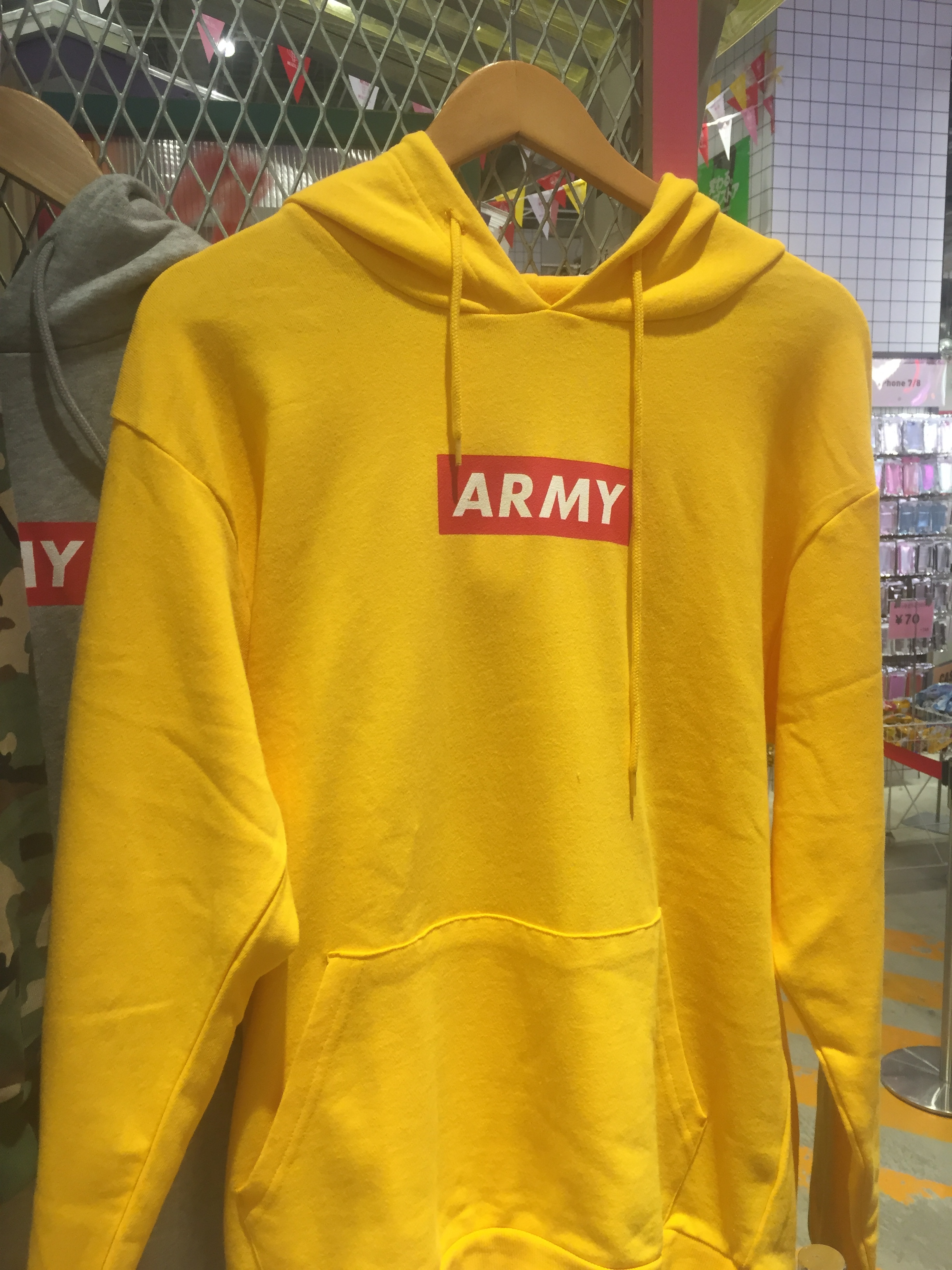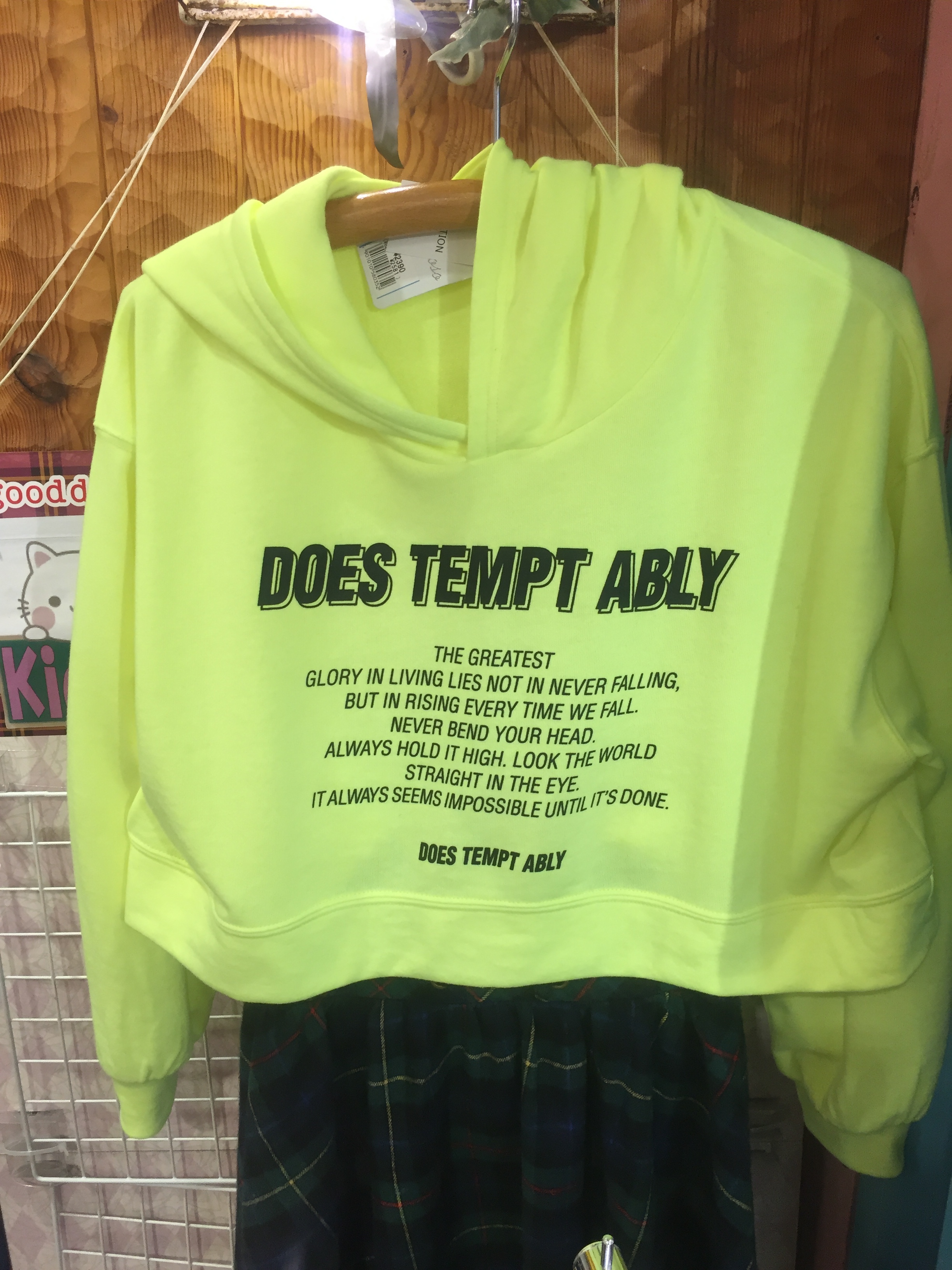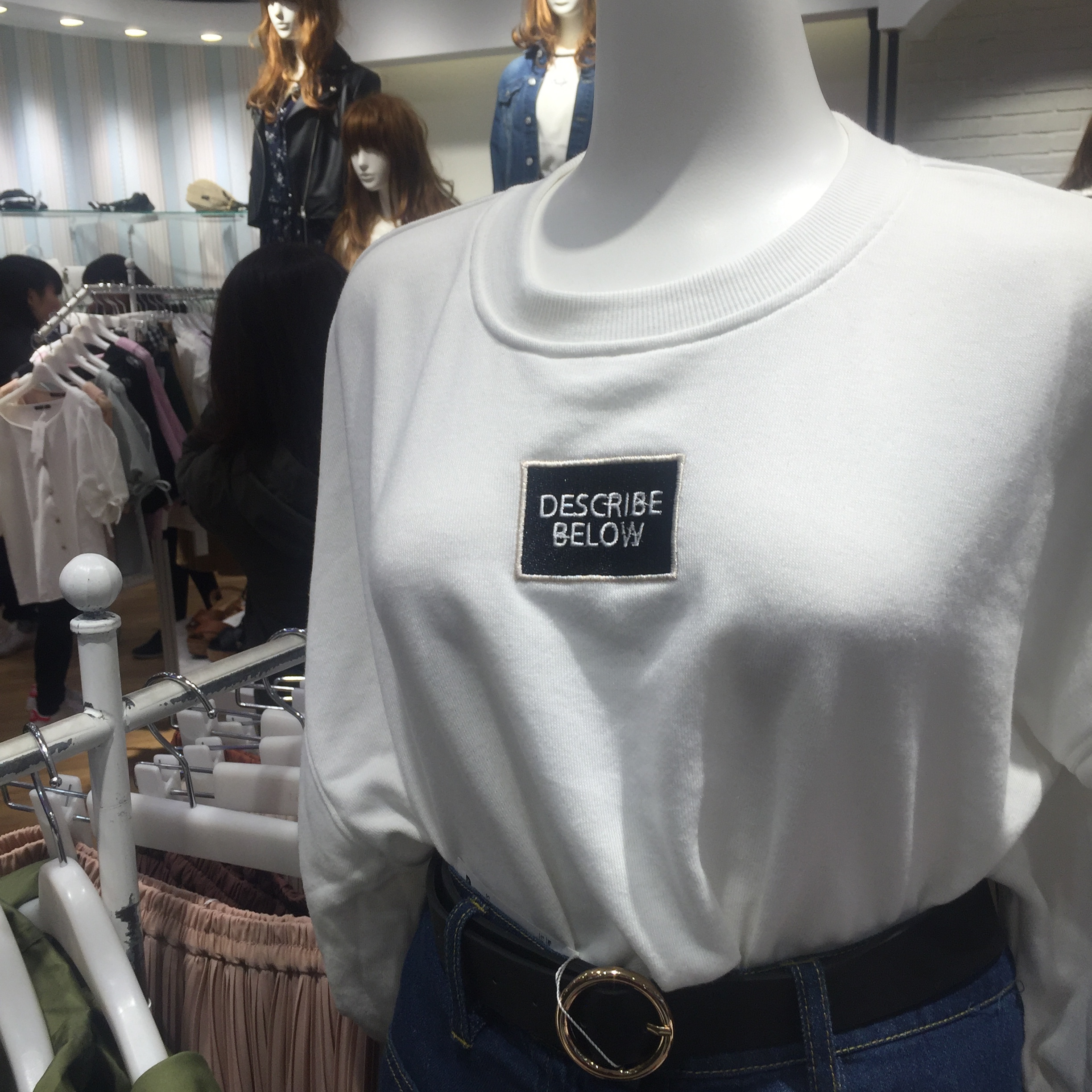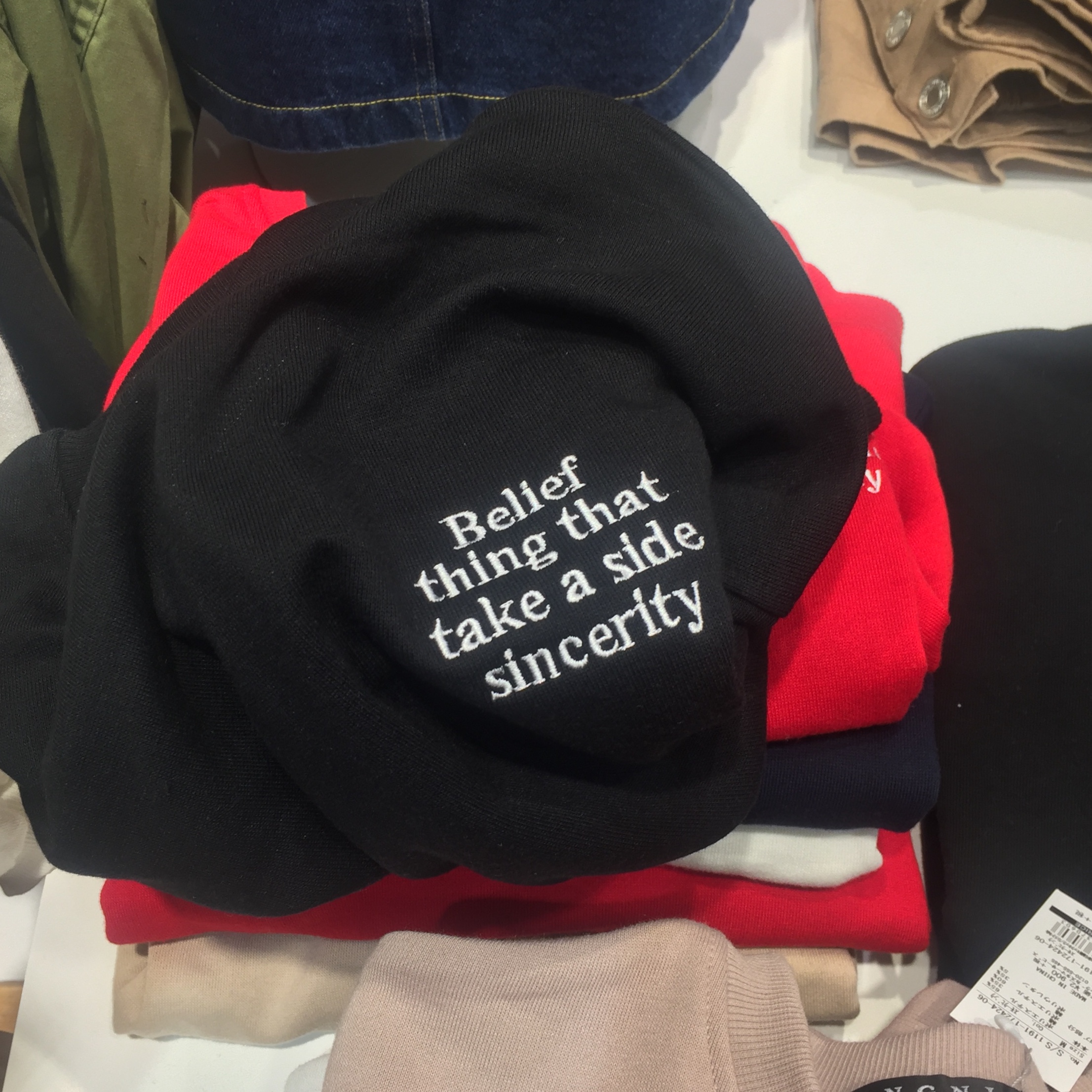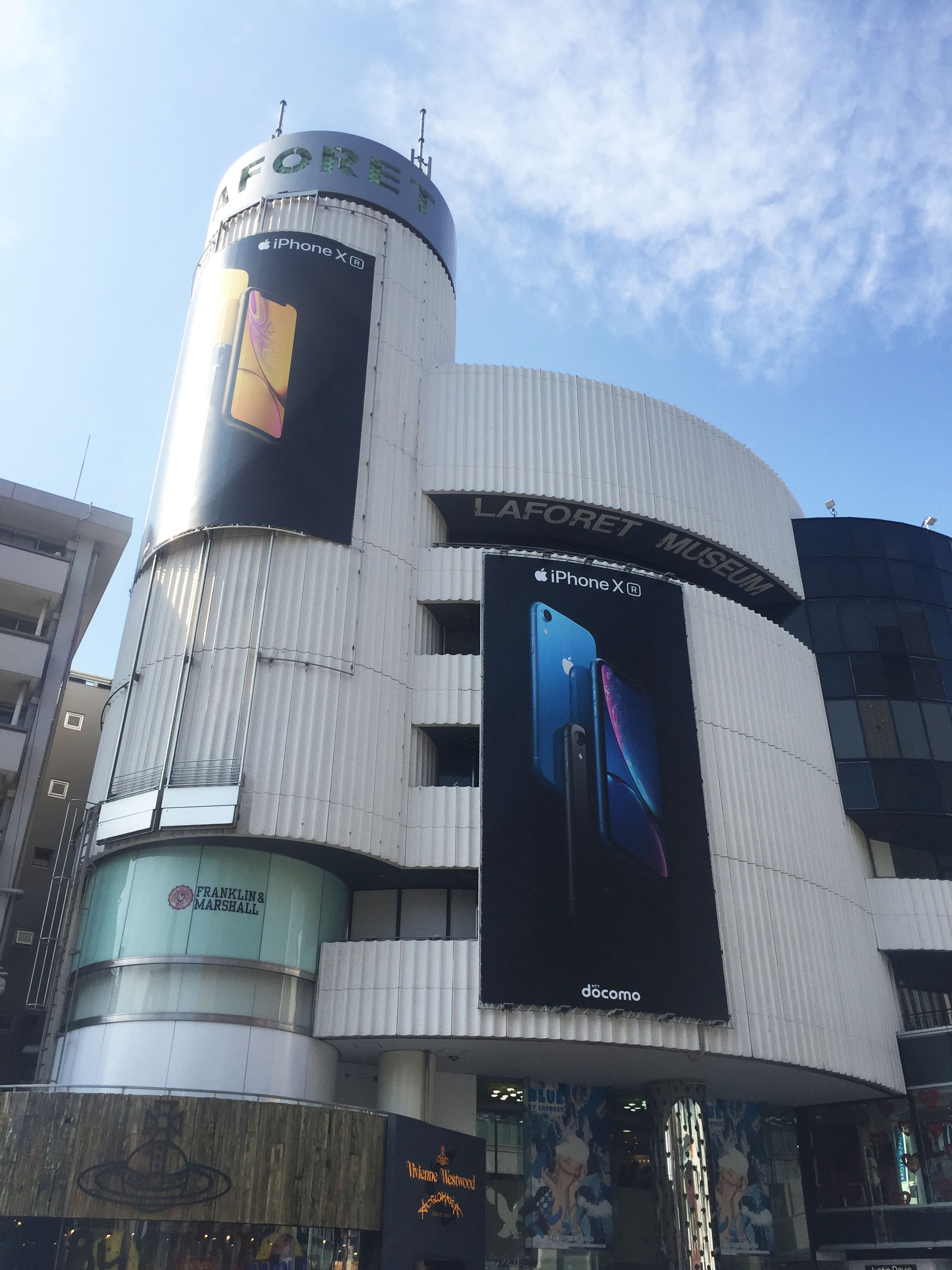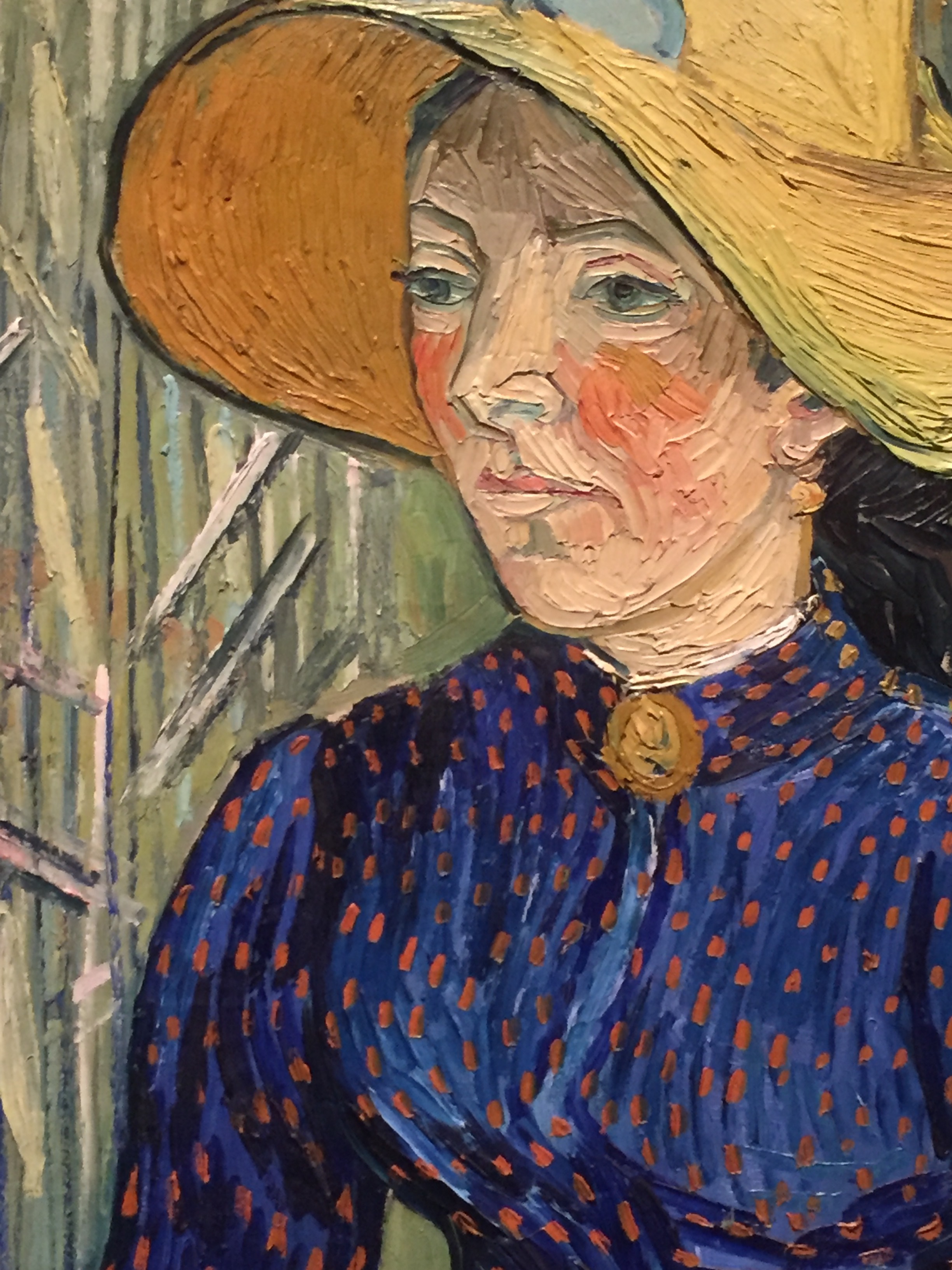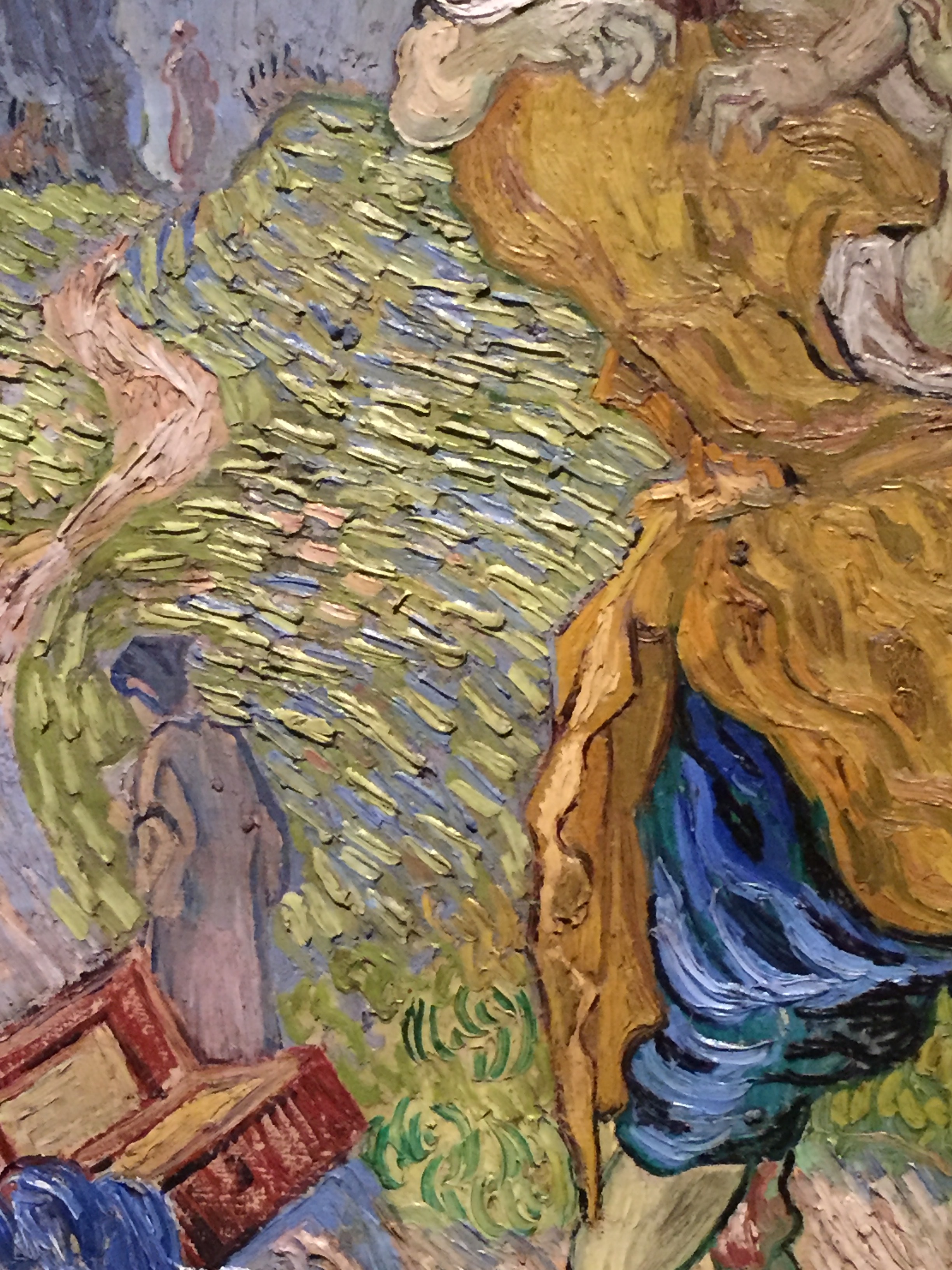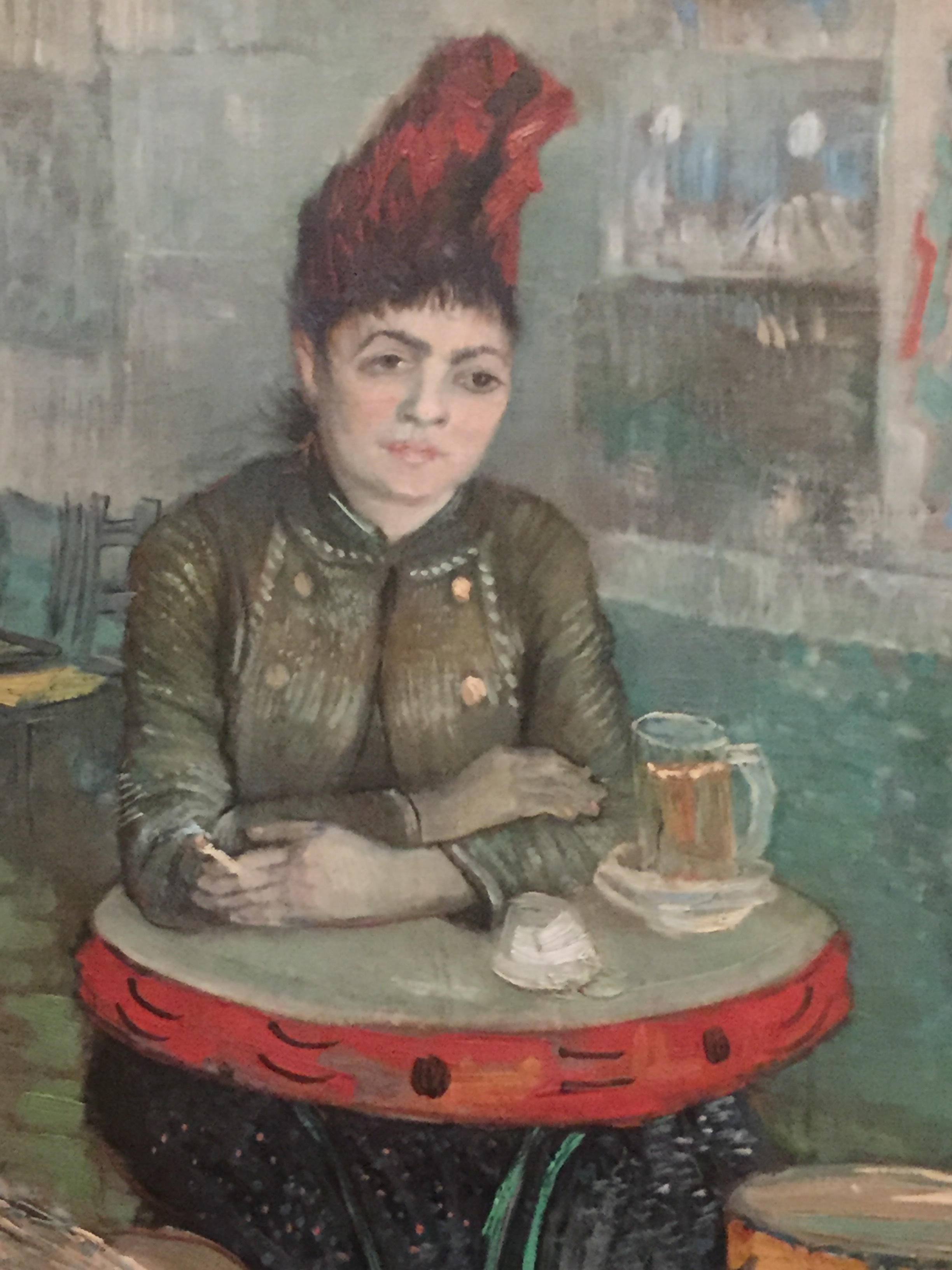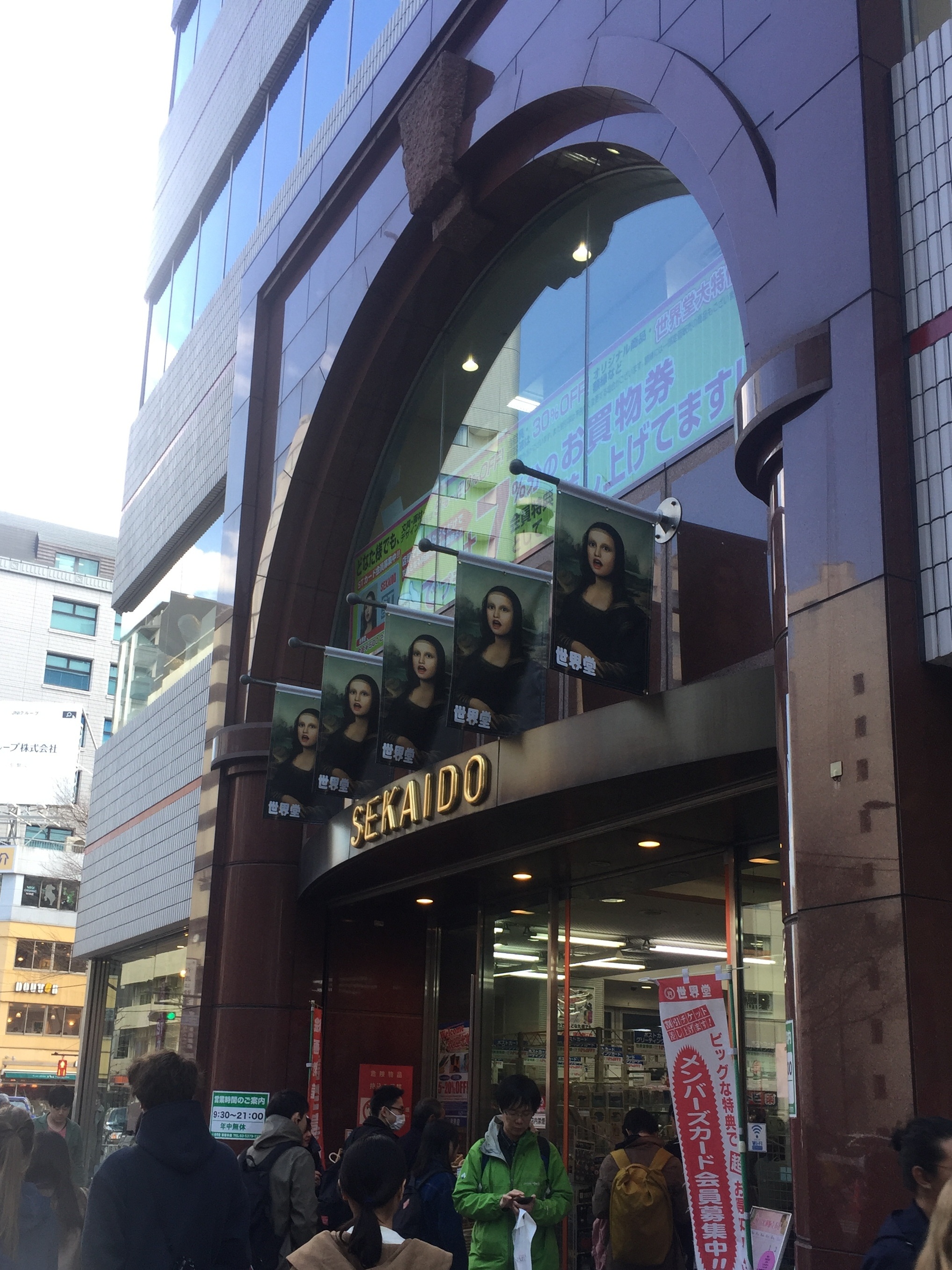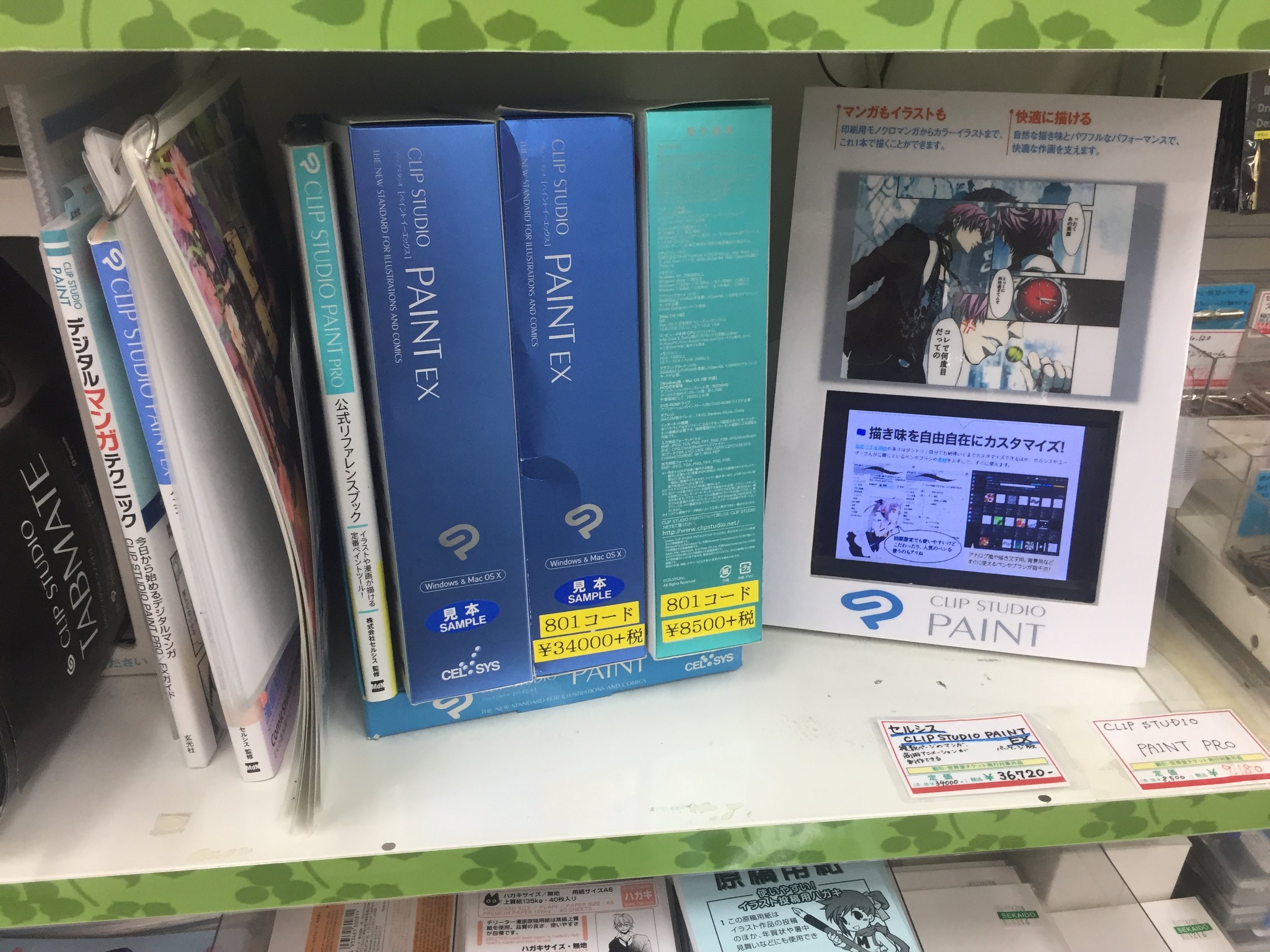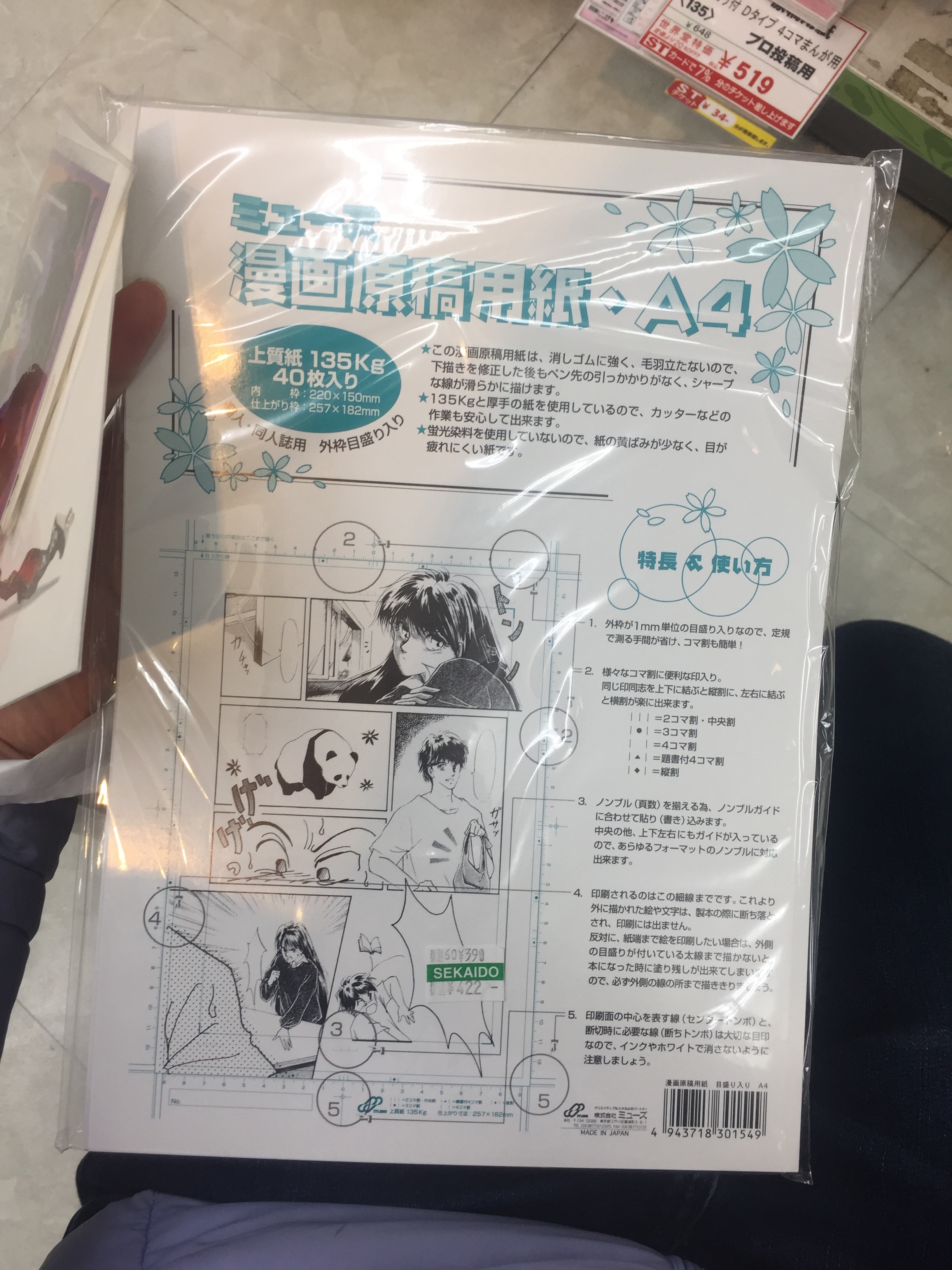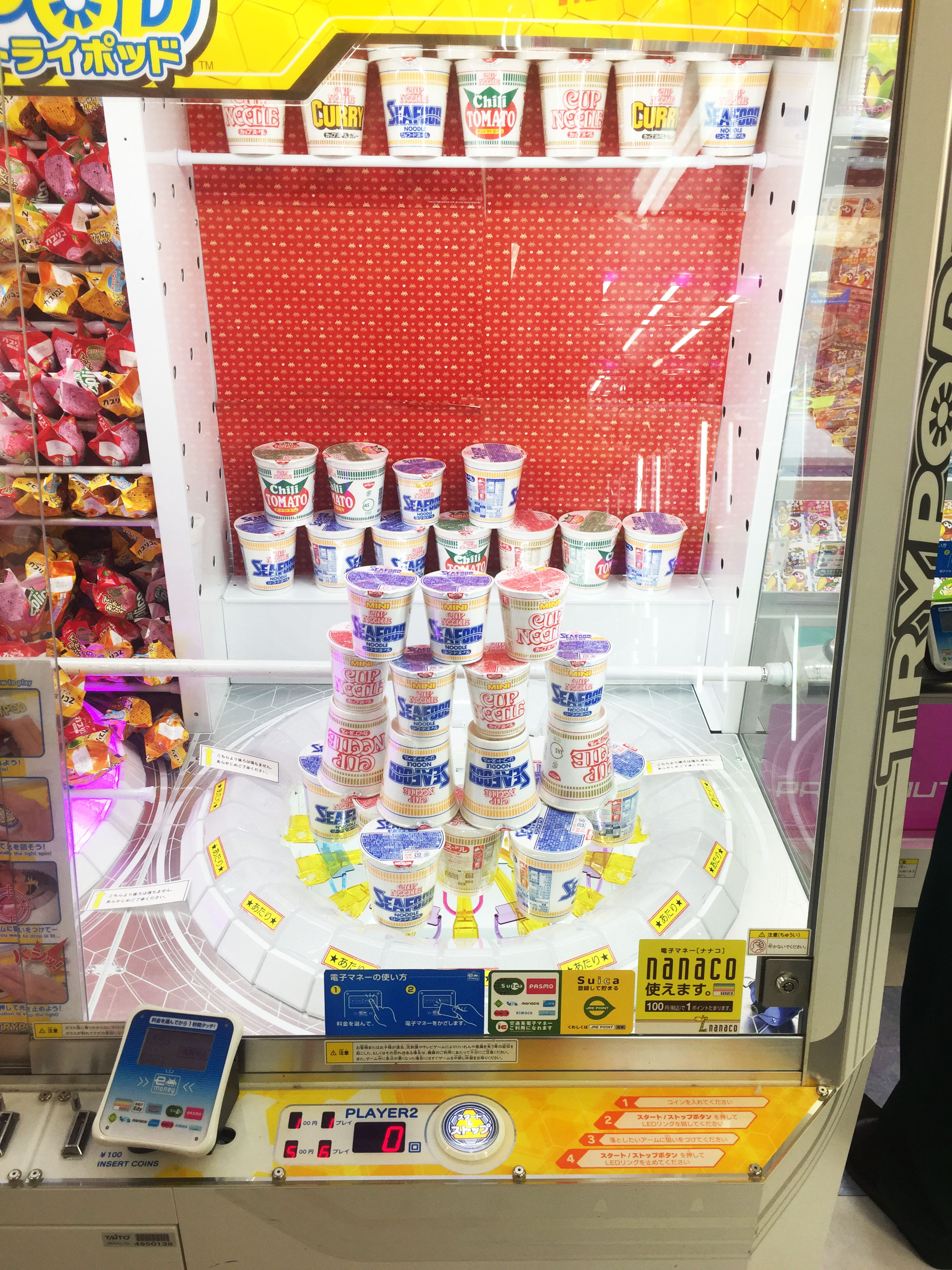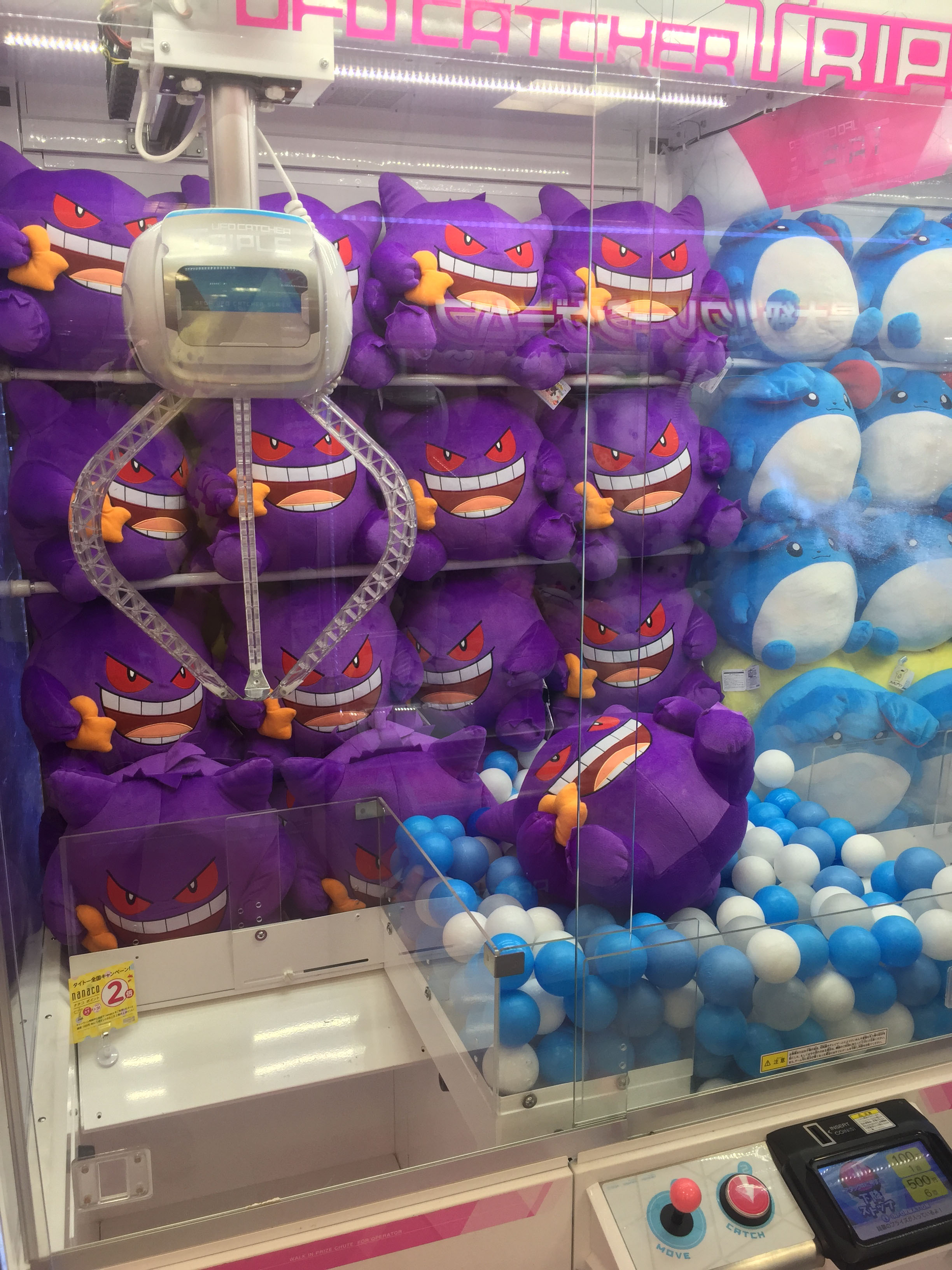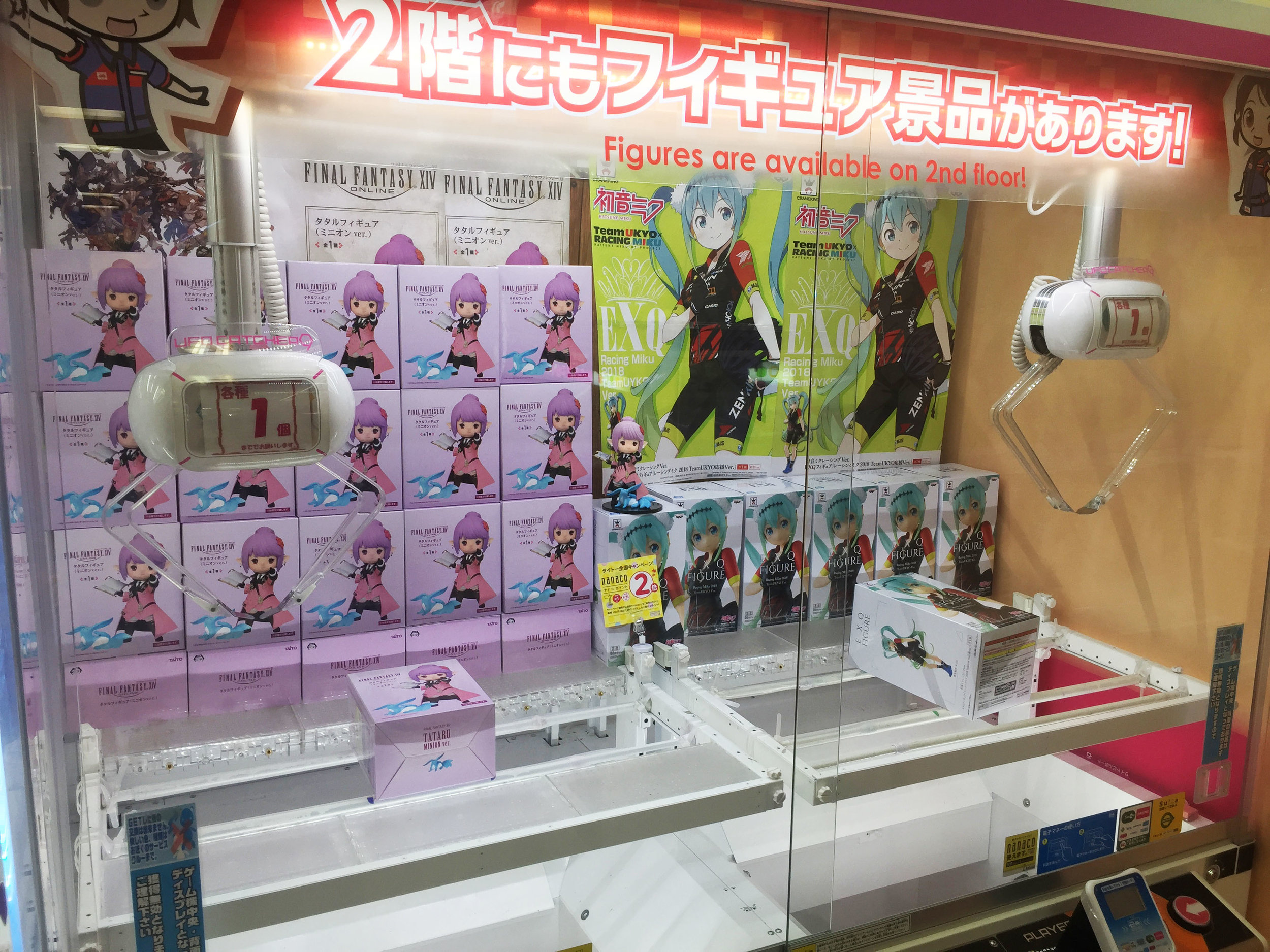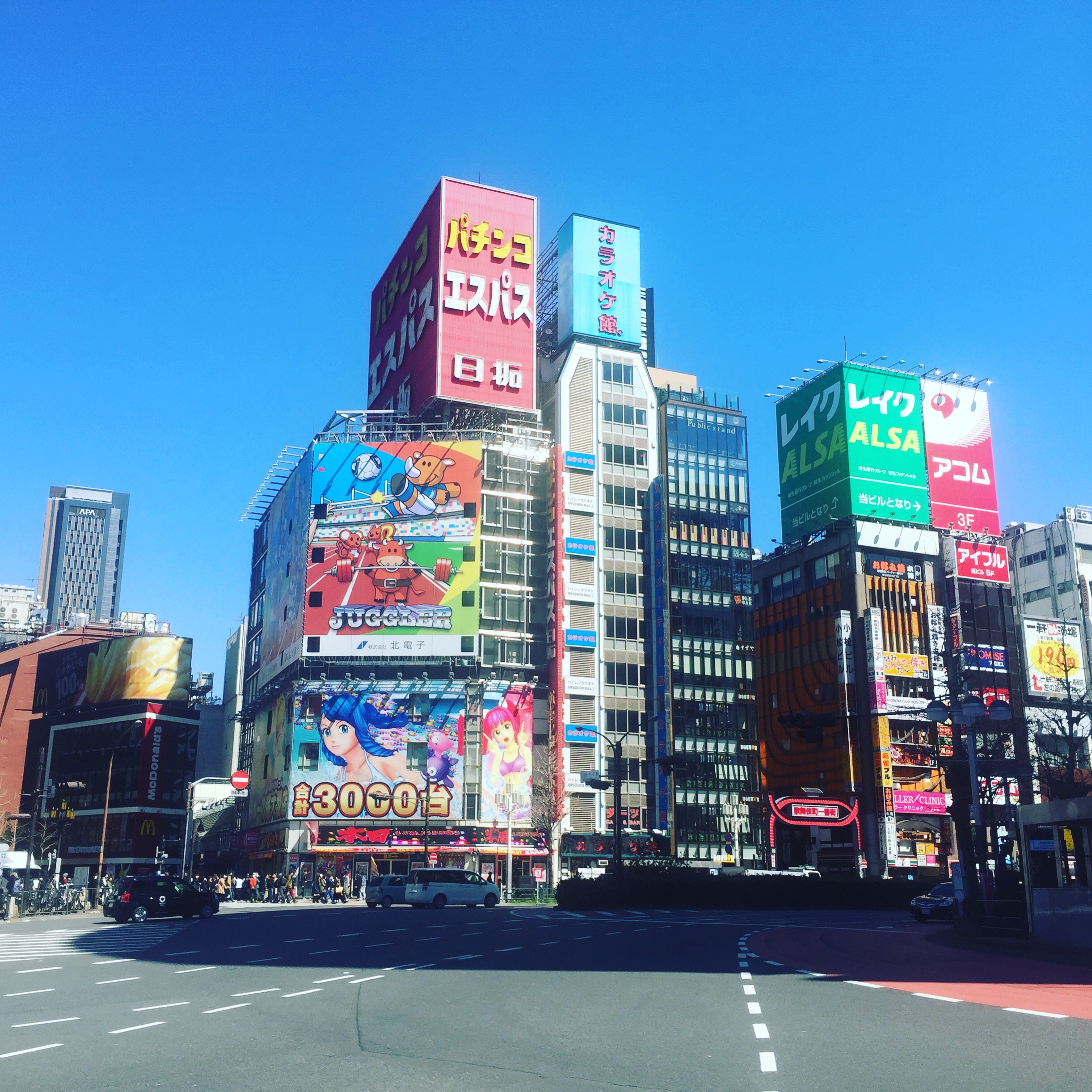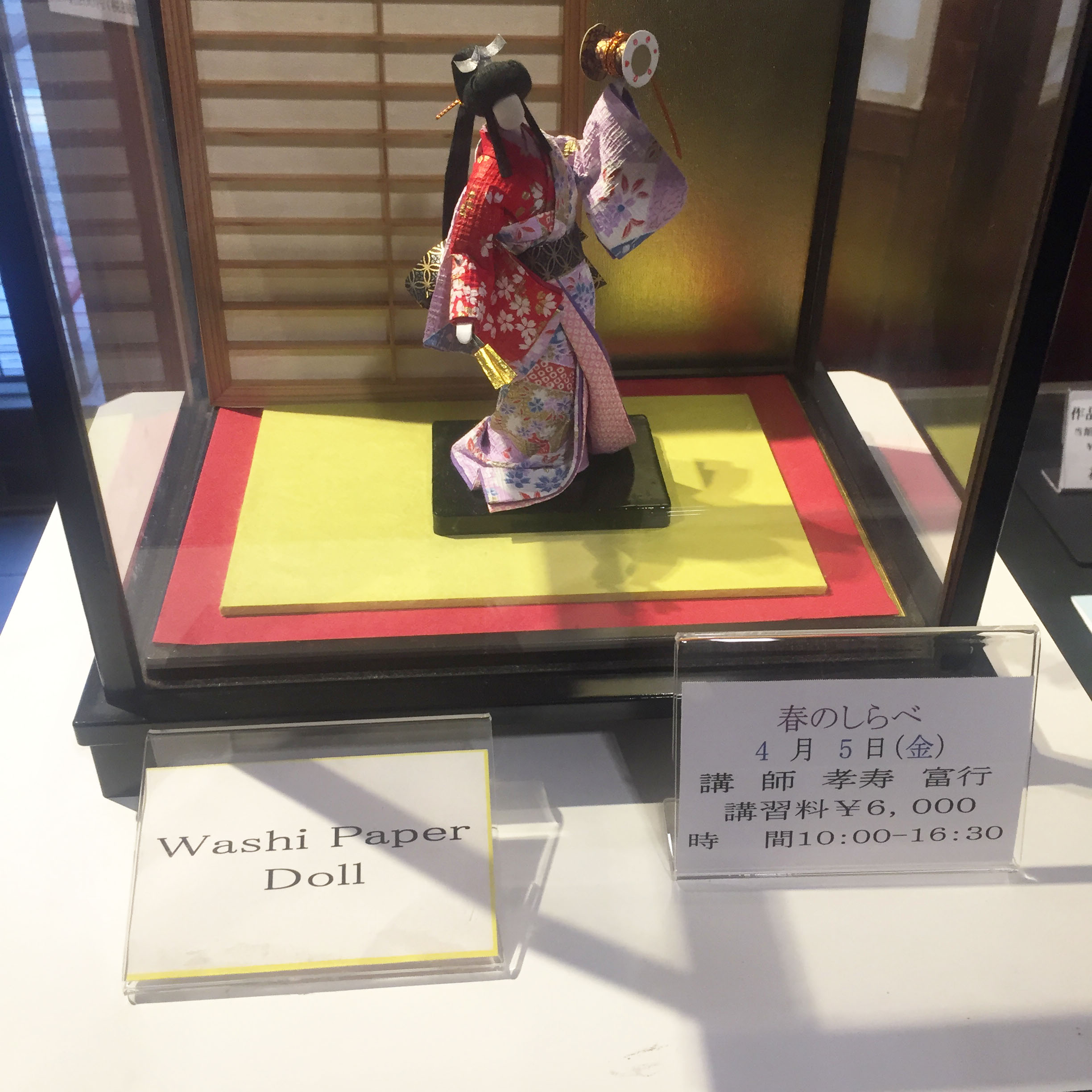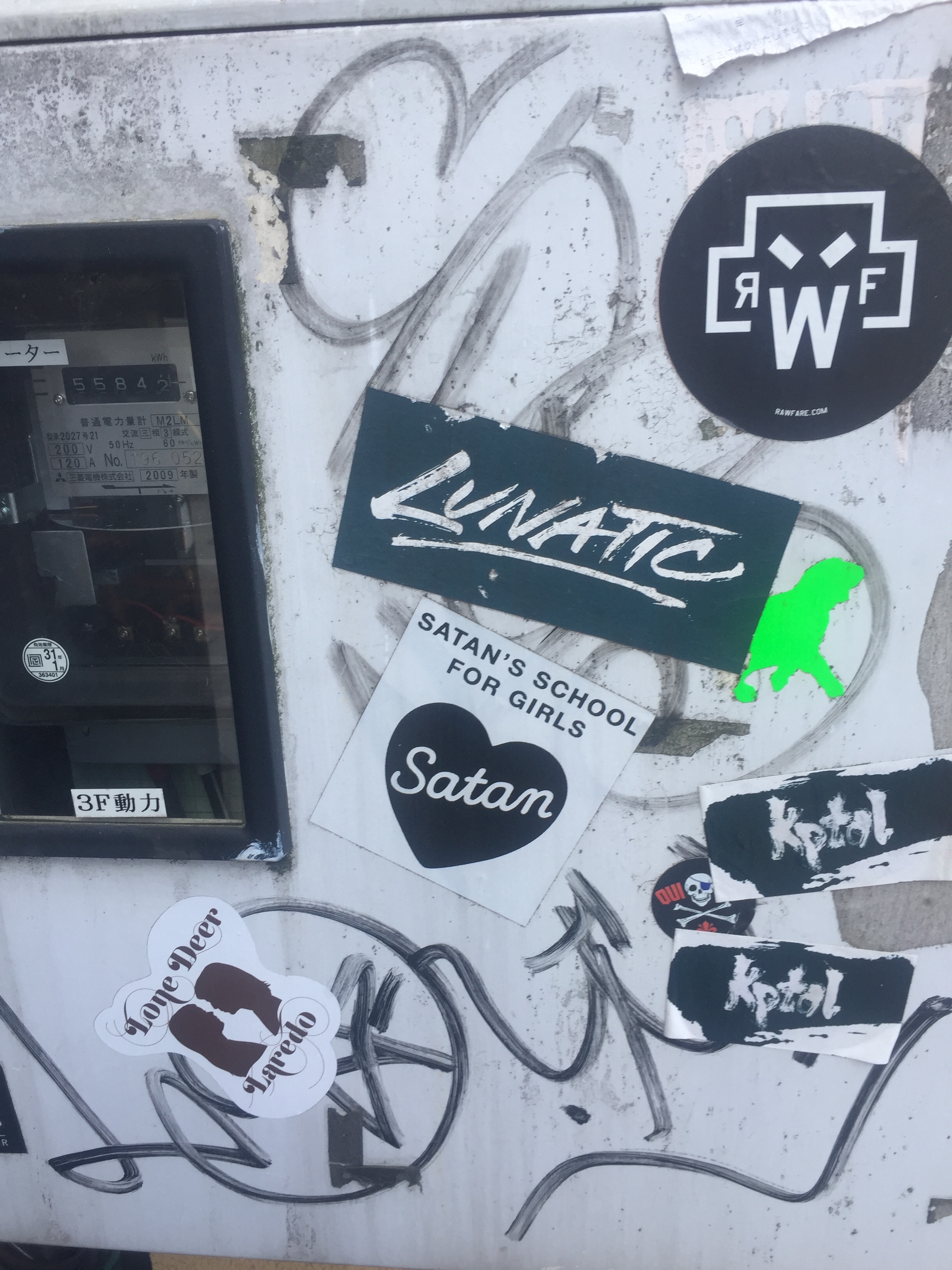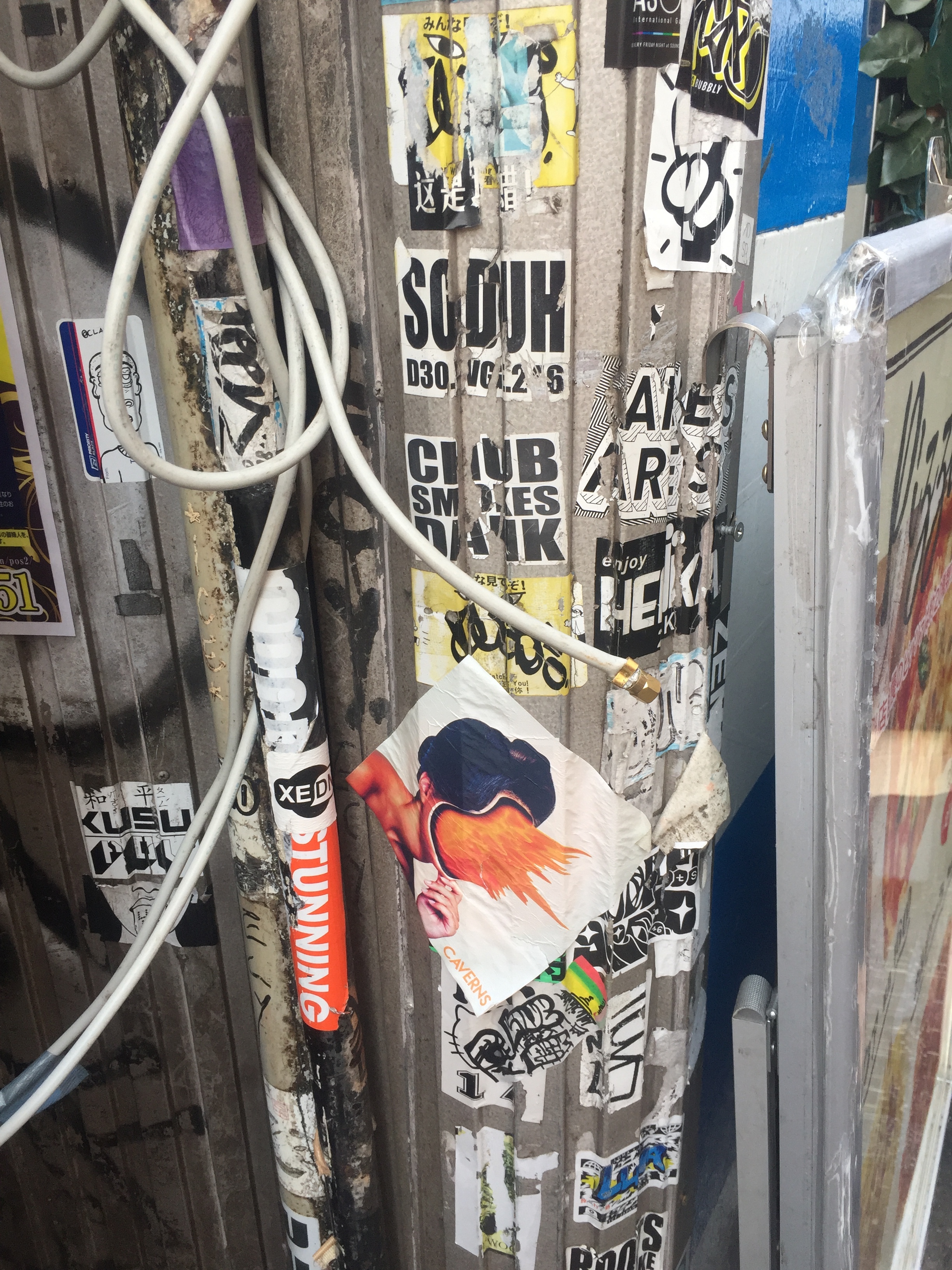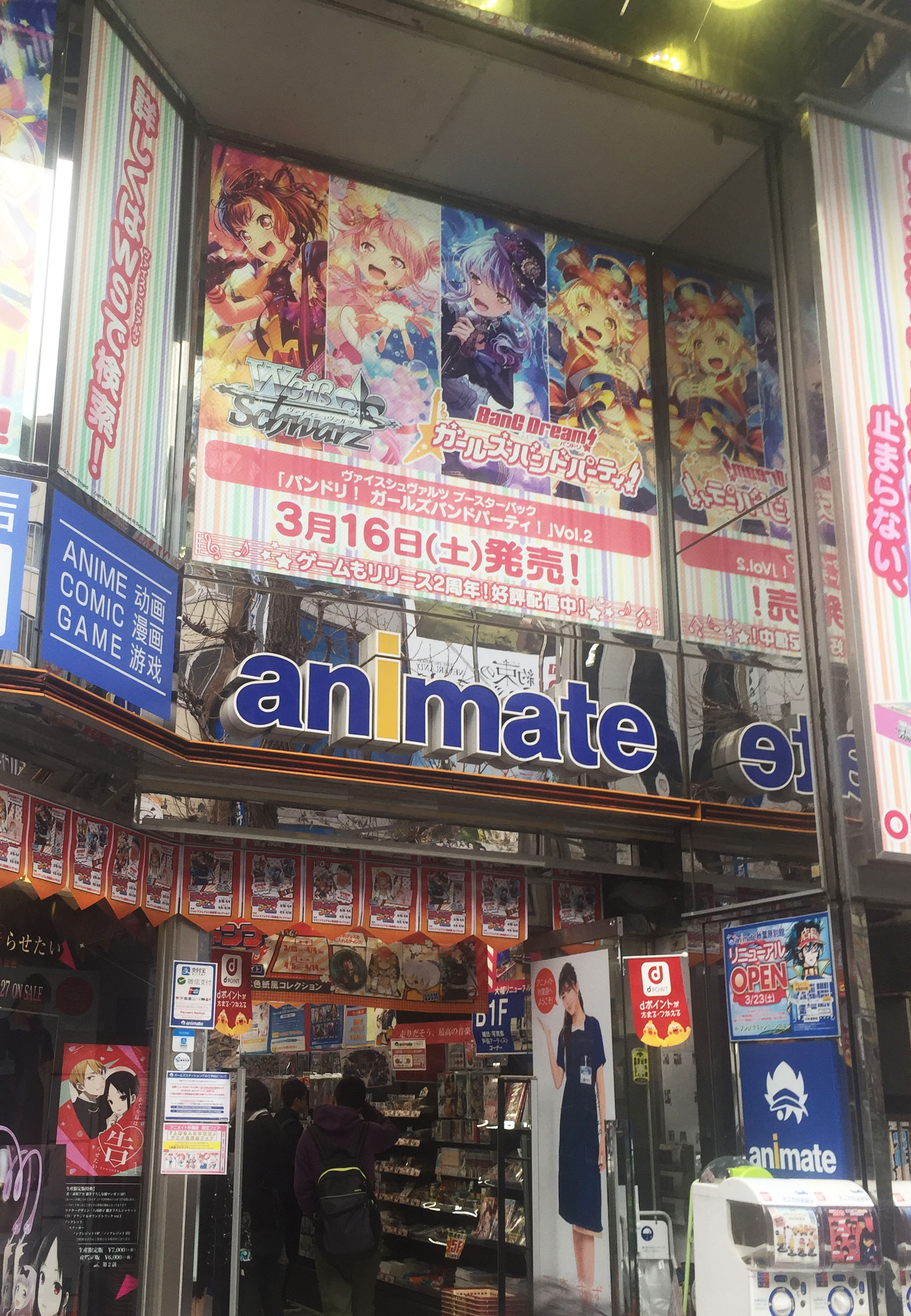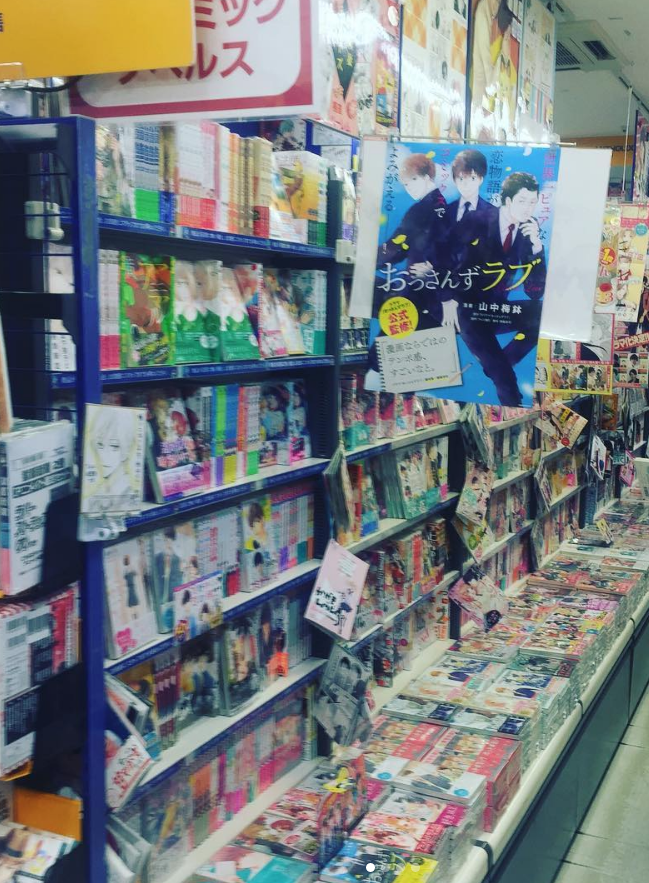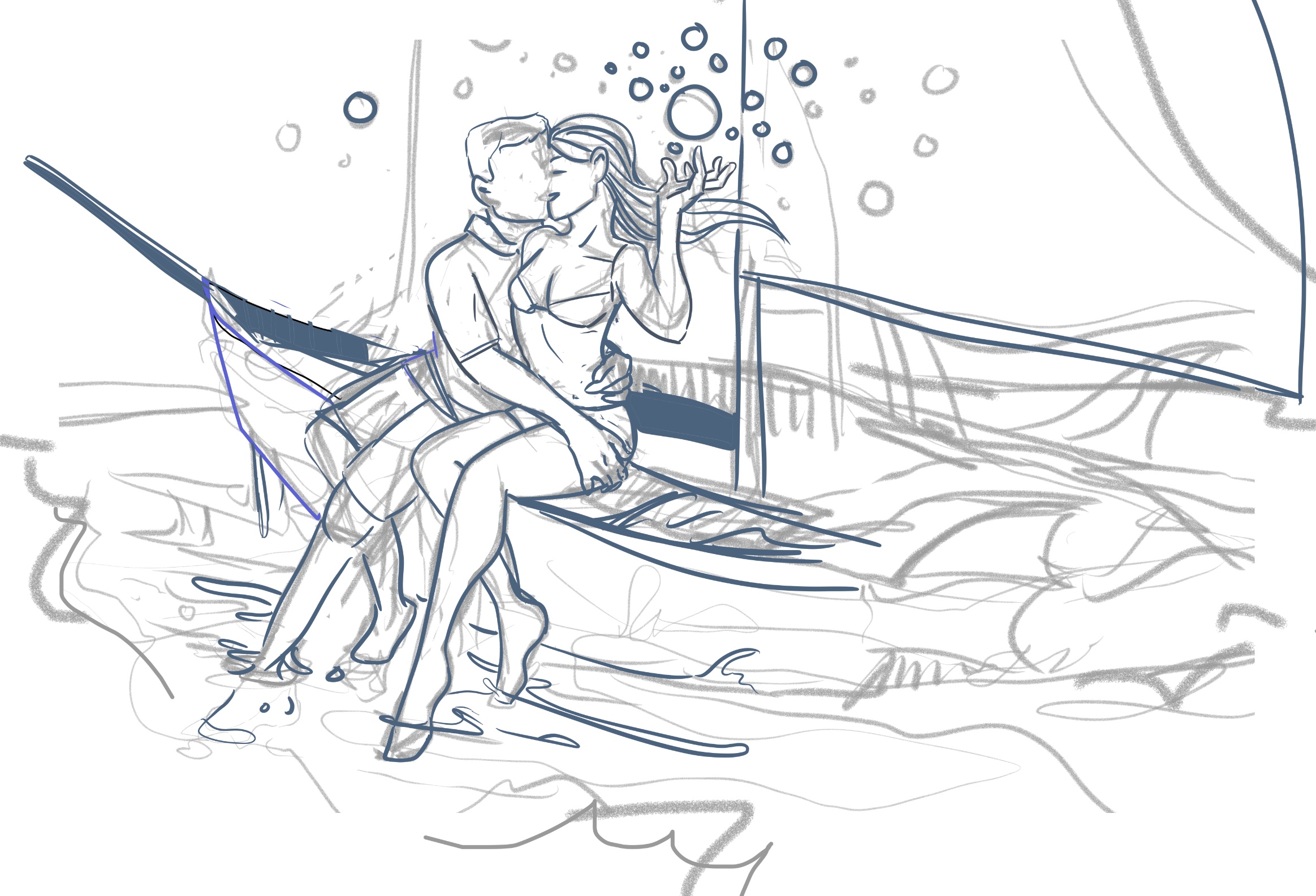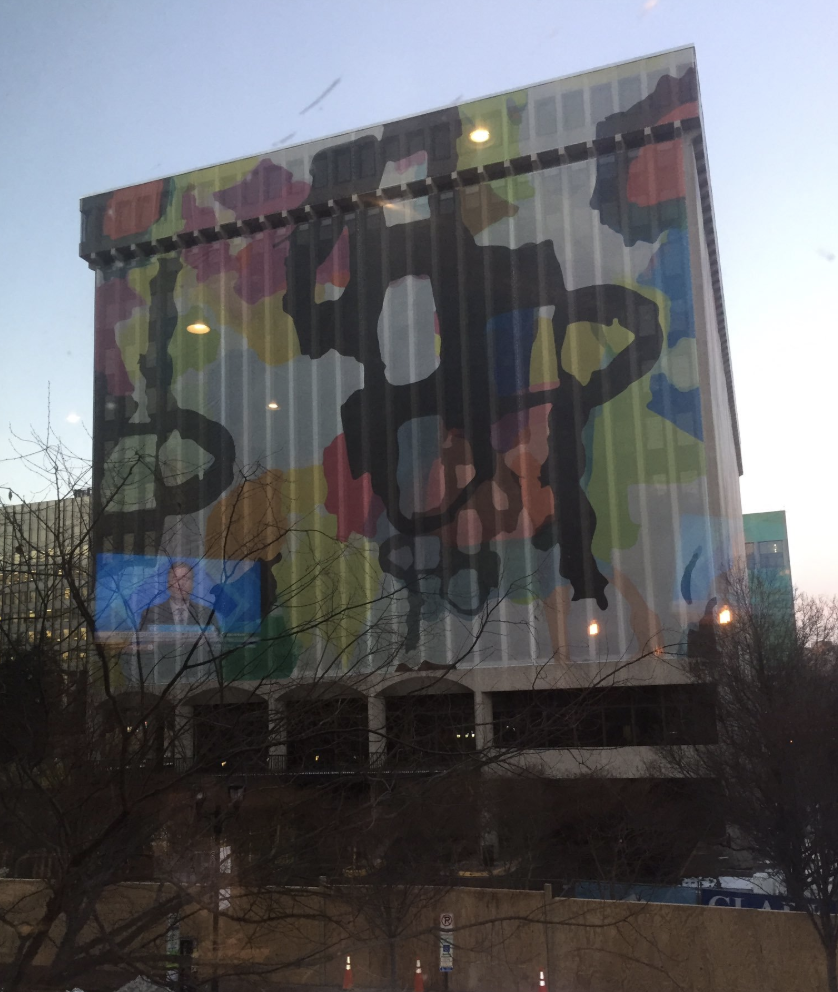Plein air painting is about being fine with pure chaos.
Read MoreCherry blossoms in Nihonbashi
Tokyo Mix: Gundam Cafe, Godzilla Store, and Maruzen Nihonbashi
The best thing about any city are the things that don’t fit neatly into a listicle or a 5 minute youtube video. The best things a city has to offer are secrets, places that aren’t perfect, and off-the-grid moments that aren’t going to get any likes on Instagram.
Gundam Cafe in Akihabara
The Gundam Cafe isn’t great for food. It’s not going to win any awards for service or cuisine. But, it is a fun place to rest your feet after going up and down multiple reps of six-story buildings. There’s no line, no weird reservations and no wait.
Sadly the noodles I ordered were lukewarm, I wasn’t sure if they were supposed to be served cold, or hot, or if I was just an idiot, but I didn’t care that much because I was able to watch Gundam theme song intros on repeat with several of my fellow easily-bedazzled Americans.
As a 14 year-old I watched Gundam Wing secretly on my grandparents’ tv in Houston via Adult Swim. Our channels in Colorado didn’t even have Cartoon Network (which is also how I got hooked on Pokemon, but, different blog for that). Anyways, at the Gundam Cafe, I didn’t care if the noodles were cold, in fact, the cold noodles made sense. They felt good in a desperate way, like eating McDonalds in Kansas after driving a thousand miles. Even though the drive across Kansas sucks, you’re still a million years ahead of the pioneer who died on the plains trying to get to San Francisco. You’re still taking Xanax instead of getting thrown into an asylum.
The menu design and coasters are the reason to go to the Gundam Cafe. Art and your Gundam Memories are the reason to go to the Gundam Cafe. Just order whatever, swoon over the menu’s design, not the food, watch the Gundam theme songs on the big screen and call it good.
Ideally Gundam would be better served by a museum somewhere, but there can’t be a museum for every anime.
Or can there? Prove me wrong … ;)
Godzilla Store Tokyo in Shinjuku
I thought I had seen all of the Cherry Blossom fever, until I was floored by this cherry blossomed-themed Godzilla diorama at the Godzilla store in Shinjuku.
One of the coolest things about Tokyo is the hyper-specific stores. There isn’t a Godzilla shelf in a Target, there is an entire Godzilla store for all of your Godzilla needs, hopes, and dreams.
The diorama above the gachapon machine is pretty cute! Even Godzilla loves gachapon!
Maruzen Nihonbashi
Maruzen, a bookstore chain, is worth checking out in any location. It was fun to visit Maruzen in Nihonbashi and catch up with what everyone was reading.
I loved how books for adults had illustrated covers. The most serious subjects had cartoon covers.
In addition to Harvard Business Review and Radical Candor, Strengths Finder is in Japan!
I saw the ‘Life Shift’ book several times on bookshelves in Tokyo and thought several times about picking it up. I thought it was the Aleta St. James book, but, I couldn’t figure it out for sure.
The most interesting shelf of books was this one, dedicated entirely to manners and grooming for men. There were similar areas for women, but I’d never seen such a focus on this in any Western bookstore. Where other cultures might be trying to say ‘looks don’t matter!’ right now, urban Tokyo is unafraid with admitting that looks do indeed matter - the hallmark book on this being “Class Act: Appearance Matters for your Success”
The lint brushes and shoe brushes almost did me in, but they’re not as surprising as the entire 200 page manual dedicated to shoe care.
Women’s magazine’s were pretty par for the course, they looked to me a lot like women’s magazines in the States or in most of Western Culture.
The main drag in Harajuku. You can get color contacts here, sports gear, cotton candy, crepes, and the dopest shirts you’ve ever seen.
Harajuku Shirts and Shops
A few years ago I was visiting an art fair in Aspen and a big dude on a trick bike trundled across a busy intersection. Like the charmed hippo in Heart of Darkness, it was a miracle he wasn’t struck down immediately by several Lambourghinis, a Hummer, and a series of Range Rovers. He sort of looked like he was on the drug bender of his life, but, maybe he just did this every day. With some people, it is hard to tell if they are lucky or skilled, or an uneven mix of both.
As I walked through Harajuku in Tokyo, I pretty much felt like Aspen Drug Bender Bike guy. Walking through Harajuku as an American, you can feel your brain oscillating between thoughts of “Am I lucky or am I skilled?” The scores of fellow shoppers in Harajuku sort of avoid you, they don’t immediately plow into you, but you also have to work for it.
My inner self glaring up at the diffused sun, for reassurance, I wandered into a Harajuku store with several stores in it, an unfolding Russian Doll minimart where each brand had a dedicated floorspace and cashier. Unseparated by walls, the brands ran together, yet they didn’t. If the streets of this place felt crowded and too small, the shops watered down some of the chaos.
Here, the real mind-oscillation begun. Harajuku has the funniest, most zen shirts I have ever seen in my life.
Step by step, have a time
Keep ideals, spite of all. At first it doesn’t make sense, then it is zen
Seen above: Does Tempt Ably, Army (Not the real Army), a $2000 leather jacket based on an episode of Adventure Time, Describe Below, Belief Thing That Take A Side Sincerity.
I stared at the subtext of this makeup store for an awkward amount of time. To my jet-lag addled brain, the words seemed to shine, emblazoned on the vinyl signing like some kind of modern Charlotte’s Web:
Self confidence and liking yourself greatly benefits the process of becoming beautiful.
It felt like reading a weird translation of Ovid’s Ars Amatoria, where an ancient and wise person was dishing on some eternal beauty facts that transcended any issue of Allure or Cosmopolitan. This store contained the secret to being beautiful, but the biggest secret was to like yourself. … What?
So (In Jerry Seinfeild voice) What’s the Deal With These Shirts? I really don’t know, but I loved the elaborately-written sentiments much more than I loved, say, a shirt with parrots and pineapples on it in the youth section at an American Macy’s. I’ve never seen shirts with so much to say.
Even if the zen-garbled sentiments aren’t fully understood by the person wearing the shirt, it’s not like every person in North Dakota with a Kanji tattoo knows the true meaning of the characters. Most Kanji tattoos probably translate to Belief Thing That Take A Side Sincerity.
Before visiting Harajuku, I saw a lot of other, more techy neighborhoods in Tokyo and a lot of western society’s problems solved: fast trains, omni-available healthy food, and safety in the form of unlocked bikes and polite policeman.
Yet, Harajuku solves one of the biggest Western plagues of all: the samey Hipster.
The helixing vicious cycle of Hipsterism is that it’s a movement toward individuality, yet, at a certain point, all hipsters start to look the same. There are only so many flannel pieces and tight-fitting jeans and boots you can buy, only so many carefully-sourced Anthropologie sweaters you can throw on yourself before you look exactly like the person next to you.
The vibe in Harajuku scatters away from the curve towards sameness. It’s on some other kind of graph altogether.
While the main walk in Harajuku pops with funny shirts, colorful contact lenses (legal!) and crepes, the real fashion gems of Harajuku lay enclosed by LaForet, a multi-level mall. LaForet has the magic of small, super small, and hyper-curated items that don’t appear anywhere else. Each store is like viewing an independent art show. These aren’t famous labels or famous names and they probably never will be, but they’re really fucking cool.
In addition to clothes each shop has hand-curated accessories, like the hip-things section of Urban Outfitters, only with the cultural memory of a person you’d actually want to hang out with. There’s Kermit the frog in a mini shopping cart, for some reason. Drawings that seem like they were made by your little sister. Pez dispensers? A Toy Story book straight out of 1998.
LaForet is home to the Sailor Moon store as well! One of the greatest things about Tokyo are the popup shops in malls that are dedicated entirely to just one anime, show, or pop culture phenomenon.
United States malls are great at pumping out aggregate pop culture fashion aimed like a laserbeam at youth culture and the even-more-lucrative geek culture - Box Lunch and Hot Topic are sure to have your favorite Godzilla T shirt. At Hot Topic, somewhere between Linkin Park tees and Full Metal Alchemist wallets, you’ll find Sailor Moon stuff, yeah. Tokyo draws in enough fandom, enough otaku, to have an entire Godzilla store, several stores just for Kirby’s Dream Land, and countless popups dedicated to new short runs of Anime.
It’s easy to see Harajuku and Laforet as a place just for young people. While there were mostly younger people in the mall, Laforet caters to one kind of person: those who want something both new and good. So, Harajuku proves to be another place in Japan that goes all out. Expression is everything and uniqueness is everything. Though I spent enough time in Tokyo to eventually see a sweater repeated in Shinjuku and in Harajuku, in both places, you get the feeling that if you don’t buy the piece today, you’ll never find it again. Harajuku is a bit punk this way. It’s not a thrift store, not Prada, not Macy’s - it’s a kind of fashion shopping experience that could only exist in Tokyo.
Possibly the best one
I feel this
I knew I’d reached peak Harajuku when I found a shop with what seemed to be every ski jacket that my family and I wore in Colorado in the 1990s. At this point, I exited the store, texted my friends in the States who might have still been awake, and bought a crepe to relax and watched the crowds roll by until finally, all of the teenagers evaporated into the metro and I could go home. I metroed back to my Air BnB and flipped through my camera roll on my memory-starved iPhone, reliving the shirts one by one, laughing and texting them to whoever I thought might still be awake in the world, throwing them up on Facebook and Twitter to prove, somehow, that all of the shirts were real all along. Truly, there is a Harajuku shirt for everyone, every personality type can be found in the mystery of a shirt in Harajuku. I went back to Harajuku the next day.
Steal The Show
This book probably falls on a spectrum for most creators and most professionals - depending on how much time you’ve spent in drama classes or at Toastmasters, the approach in this book could be anywhere from totally new to you, or advice you’ve heard before.
But wherever you fall on the spectrum it doesn’t matter, because Michael Port’s writing is fun to read and isn’t accusatory or pompous. He’s like a cool dad who wants you to rock the presentation, get the job, ace the keynote. He’s like your drama teacher without the drama.
The pieces of advice might be things that, deep down, we knew were true, but it’s nice to have Michael Port in your corner reassuring you. It’s fine to assume multiple personas, he says. It’s fine to rise to the role, in fact, it’s great! Yay.
Michael Port never pitches the idea of life-as-a-movie or life-as-a-tv-show, but instead he pitches it as life-as-role, and you can take multiple roles. In fact you should take multiple roles. It’s what modern life demands from us and we can rise to this occasion.
I used to spend time with people in entertainment and met a few indie-film actors. One might think of actors negatively in the same way that people think of artists: if they’re good at acting, what if they are good at faking, embellishing, manipulating?
Turns out none of this needs to be a concern. Actors are among the most genuine, sweet people I’ve ever met. They’re studying and creating, and sometimes they get chosen for roles and sometimes they do not. They’re doing their best for a job they’ve been hired to do, for a role they have been selected to play.
While casting directors and job interviewers and bosses can all-too-often be seen as antagonists or gatekeepers, deep down, they want you to succeed. They want you to wow them. It’s your job to make big, strong choices.
Michael Port tells us that if actors can do it for roles, non-actors can do it for the many performances of life. In this mode of framing life-as-performance, Michael isn’t teaching us how to become an actor or how to get famous (thank god). What he is saying in this book is “You already are an actor! Here’s how to get good.” The confidence in this book is infectious. I felt like I had just climbed a mountain with the coolest person I know.
Like a good keynote, the book didn’t drone on and on. At first I found myself wishing that the author had included a few more anecdotes of how he worked with his students to overcome their fear, then I realized he didn’t have to do this, it would have been too much.
For the introverted like yours truly, it’s probably true that just reading a book won’t help us perfect our public speaking goals. Along with Steal the Show, Michael Port has built an entire public speaking empire, a website, classes, and his own keynotes. This book is just a book, it’s just step one. Yet for being ‘just’ a book, it’s a well-voiced, active, stagelike read.
Like some kind of ride, I wished this book were even longer and I was sad when it was over, so I went back and reread several points. It’s the ‘Let’s ride it again’ at Disneyland kind of book. You’d want to lend this book to a friend that you care about, but also buy another copy for yourself just in case.
Related Blogs:
Art Reads: Richard Feynman’s Six Easy Pieces
Shin-Koenji
Like a bead of water on a glass, Shin-Koenji is just one tiny glittering piece of Tokyo.
During a ten-day trip in Tokyo, I stayed near this shrine, the Myoho-ji temple. Across the street is a grocery store and a 7-11, and its near the Shin-Koenji station for a relaxed metro ride into the city. The metro wasn’t even bad during morning rush hour - more often than not I could find a seat.
Graveyards and temples, an art school, a small park - while I can’t say Shin Koenji reminded me of anywhere else in the world, it was the picture of peace and order. Like taking a ski run for the first time and already knowing it like the back of your hand, Shin Koenji is a safe and easy place to stay while visiting Tokyo. It’s not as exciting as other districts of Tokyo, but it doesn’t try to be, either. It was cool place to relax after visiting the city each day, a cool place to make a lot of art in the evenings.
On the last couple days of my stay in Shin Koenji the sky lit up like this.
Narrow streets cut through Shin Koenji and even more alleyways connect the neighborhood. It’s a great place to be a pedestrian or a cat. It’s easy to find your way through this neighborhood as most people seem to have a path memorized to and from the subway.
A sunny day in Shin Koenji - mirrors were used to make traffic easier to see throughout the narrow, tightly-cornered streets.
The metro station at Shin Koenji was chill throughout most of the day - the only time to really avoid was the 9 am rush hour where countless workers were jamming in to each car to get to work each day.
Here I am at my Air BnB in Shin Koenji!
Vincent van Gogh: His Life in Art at the Museum of Fine Art Houston
This show of Vincent van Gogh in Houston is one of the best Van Gogh shows I’ve seen as far as diversity of work and the message of the show. Not every Van Gogh painting is here, but there are definitely paintings that are rare, less-seen, and drawings that floored me. Starry Night at the MoMA and Self Portrait at the Musee d’ Orsay are probably the two Van Goghs that we think about most, this show gives us reasons to see lesser-known Van Goghs in an iconic way.
Like the following three paintings after Millet:
Detail of the above painting, where the paint isn’t brushed on so much as applied like patches of bricklaying cement:
To this day I don’t know how Van Gogh painted this way. A brush doesn’t lay down color like a trowel, and to do it with a palette knife you’d have to have the patience of a saint. We all know the painting is a lovingly-made replica of one of Van Gogh’s art heroes, Millet, but how, how the heck did Van Gogh do this?
How did he paint like this, with the volume of the paint jutting out from the painting? Brushes press down paint and smooth it out, palette knifes lay down color, but there isn’t a tool in painting that lays down little embossed swatches of paint like the green swatches above. There just isn’t. Whatever Van Gogh was doing, he was using paint in an absolutely new way. He was laying it down and then shaping it, or he was loading his brush for every single stroke, dipping the brush and hitting the canvas, dipping the brush and hitting the canvas, over and over again. This would be an incredibly hard - but rewarding - way to paint.
In paintings like these, copies of Millet’s work of peasants bundling hay, the paint is applied and shifted in a way that would be less maddening. You can see that Van Gogh laid down colors and then shifted them, sculpted them across the canvas, later adding touches of atmosphere like the purplish haze around the hay and sky below.
Van Gogh never saw these peasants but he was often thinking about them. He loved Millet and cherished Tolstoy and ever since Potato Eaters, was more concerned with peasants than most.
Van Gogh had failed at many other courses in life before setting out to paint - he tried to be a teacher, he tried to be a preacher, and didn’t make it at either. While he didn’t succeed at painting financially in his lifetime, his success as a painter eternally stemmed from his habits of hanging up paintings and prints all around him in his rooms, and writing to his brother about paintings and landscapes. In reading Van Gogh’s lettters, I’ve never seen anyone be such a fan of other painters. In one letter to his brother from 1875, he writes a short greeting and then goes on to list all of the paintings he has hanging in his room:
He was studying these paintings like he studied and quoted The Bible in other letters.
When Van Gogh copies Millet or makes a painting ‘after Millet,’ the best we could analogy that we could make for our time is that Van Gogh made unabashed fan art. The paintings above are homages, or fan art, or both.
Like a kid who loves Spiderman so much that he starts doodling, Van Gogh loved Millet so much he wanted to make Millet paintings himself. He was relentless to learn and studied the hell out of painting and kept painting, and didn’t quit even when he got sick.
The book is a homeopathic remedy book. What about the smaller onion that has fallen onto the book’s cover? Did it just fall off, is it hiding something on the cover? Unlike a spread in Oprah, It’s not the most organized scene, but the onion is kind of hiding the book.
The lavender shadow in this painting almost did me in. I’ve never seen such a bright shadow. Though this was a painting of an asylum during Van Gogh’s stay there, it looks like a great place to recover. It looks like this place would heal anything.
It was nice to see The Rocks at this show in different lighting - though in the permanent collection at the MFAH, The Rocks takes on a new light against a darker wall in this exhibition. Typically it’s on the second floor of the museum and is against a lighter wall, though still encased in an ornate golden frame. I was so entranced by The Rocks when I saw it that I wrote a small mini-blog just about this painting, nothing else. Every time I see it in Houston, there’s something new to see. And it’s unlike any other Van Gogh I’ve seen. The sky relishes with broader, more lengthy strokes than other Van Gogh skies. Pink, yellow, blue cross the canvas and lead you to believe in a wind that shakes the dark tree. I believe in the rocks in this piece. Vincent could look at what would otherwise be someone’s throwaway photo and make something iconic out of it.
Vincent had mentioned The Rocks in a letter to Theo, where he complained about dust and wind. Painting en plein air means chaos seeps in from all angles - bugs, dust, wind, time, people walking up to you and asking you about art - all of these are challengers to making a painting outdoors.
Limited time does compress talent in a good way - you have to see accurately and replicate quickly, before the wind throws dirt into your skies.
In many Van Gogh paintings you can tell when he has acquired a new paintbrush - in the painting of a wheat field above, he has a larger brush by far than in other works and isn’t afraid to set it to work in the sky and foreground, where the smaller details are worked in the strip of trees in the horizon. The painting above could have been made with the staccato, small brushstrokes of Starry Night, but instead, more generous knifings of paint complete the atmosphere.
I’d never heard the story of the painting above, or seen the painting. If you’d asked me on who had made this painting I would have said an early Manet, maybe Lautrec on a weird day, someone else, but not Vincent van Gogh.
The painting depicts woman that Van Gogh was seeing at the time. He may have painted her right there or sketched her and painted her later, but either way, boy she looks glum. She looks like she’d rather be anywhere else.
According to the placard, the relationship later took a ‘stormy’ turn. Beer in one hand and cigarette in the other, this is how you get through dating Vincent Van Gogh.
(Okay, maybe that’s not beer, but it sure looks like beer)
The thought is that Van Gogh must have been too much for most people - committing himself to asylums, getting in fights with Gauguin, rejection after romantic rejection, failed jobs, living with his parents at age 30 … people just couldn’t really stand him after a while. But who knows? Maybe we’re looking at a guy who had a lot of the same problems that guys (and gals!) in their 20s have, and 150 years later, romance, jobs, and families are mostly the same. He tried to teach, he tried to preach, but painting was what he was meant to do and while Theo was a saint of financial and emotional support, it couldn’t save Vincent.
Speaking of Gauguin, the sitter for the portrait below had been painted by both Van Gogh and Gauguin in one sitting. This isn’t my favorite Van Gogh - here is why: in it you can see that with Gauguin sitting next to him, Van Gogh was influenced to paint more like Gauguin, which is not who Van Gogh was. Gauguin was a monster to others, Van Gogh was only a monster to himself.
Van Gogh tried on Gauguin’s more abstract style but ultimately rejected it for more realism, one of painting’s best ‘Be Yourself’ moments. Van Gogh is now described as post-impressionist because he doesn’t fit in with the impressionists, either - he was really his own thing.
Vincent Van Gogh being real
A portrait that is thought to be of Theo, Vincent’s beloved younger brother.
Impasto-clad peonies.
Many drawings in this show - rare and just as dramatic as his paintings.
The drawing above of a peasant woman is an earlier work, hung early in the show. I think you’re supposed to see it as sub-par compared to Van Gogh’s later drawings, but it’s full of unexpected promise. It could be early or late and I would have believed you. Like many drawings from Van Gogh, this drawing is not afraid of darkness. Approaching deeper values bravely isn’t something that all beginners do, but Van Gogh did it here and in his other drawings.
The display case below contains facsimiles of a sketchbook at the Van Gogh Museum in Amsterdam.
Far too delicate to move, the facsimiles displayed with the tools that Van Gogh might have used bring the sketchbook closer to us.
There are several displays of tools throughout this show that are well done - a paintbrush or pen in a case isn’t something you see often, and I found myself wondering why this was the case. Why don’t museums display more paintbrushes when museums throw a painting show?
A fundamental theme running through the show, placard after placard seemed to swoon and chime over the fact that Vincent had written so many letters to his brother, 830 in total, and - swoon! - thanks to all of these letters, we know so much about Vincent’s life!
Vincent is the art historian’s cake and cakewalk and eating it too, where other painters move in and out of existence through receipts, documents, lore, apocrypha.
Yet, even after all of his letters and works, we still don’t fully get him. His lovers or would-be lovers rejected him, his friends couldn’t stand him - the only person who seemed to understand him and believe in him was his younger brother Theo.
Van Gogh was an occasional all-caps kind of guy, though some pop-art depictions and accounts of his personality would make you think he was All All Caps, All The Time
If you aren’t bold, If you don’t write it down, if you don’t draw it, nobody will know. Writing and painting, for Vincent, were both equal forms of existing and expression. Loving God and loving his brother.
After the show of paintings and a cruise through the giftshop (a well done giftshop by the way), there is an awesome interactive display called Van Gogh Up Close. My Mom grabbed this photo of me below - someone - a team of designers and fabricators - built this whole replica of a painting and you could sit in it!
There were other lifesize replicas, projections of Starry Night, and paintings on whiteboards that you could try your hand at coloring in, or hijacking.
Stuffy art critics get mad about highly-instagrammable museum displays like this but I think they’re great. There’s nothing wrong with loving art and wanting to be a part of it. There’s nothing wrong with bringing art closer to everyday life, and everyday life closer to art. Van Gogh Up Close is a perfect name. Vincent never could have imagined people in the far future running in and out of his paintings like ghosts slipping through walls, but here we are.
Vincent van Gogh: His Life in Art runs until June 27th at the MFAH Houston
Related Blogs:
Vincent van Gogh at the National Gallery of Art
Caran d’Ache Watercolor Pencils
Sekaido - An Artist's Paradise
While walking in circles through Shinjuku with a dazzled-American look on my face, I happened across what looked like a pretty cool art store. I wandered in on a lark, thinking it would be nice to check out what this store had to offer.
It ended up being the most comprehensive art supply store I have ever seen.
Floor after floor, Sekaido just keeps going up and it just keeps offering more and more to artists.
The bottom floor of Sekaido dedicates itself to office supplies and greeting card, cute Moomin things you can get for your friends, and a couple Gachapon in the back corner. What surprised me most about the office supplies was … for some reason, there were aisles and aisles full of binders. Office supply shoppers in Japan seem to be very selective and also amped to get binders, folders, and organizers.
I knew that journaling was a huge trend in Japan, but I found myself asking, in a Jerry Seinfeld voice, what’s the deal with these binders? If anyone knows lemme know! Maybe it’s just nice to be organized.
The next floors of Sekaido focused more on artists who like to paint, draw, and sculpt.
With four aisles dedicated to comics, Sekaido suggests that comic-making isn’t a deeply mystified task for extremely pissed off and stressed people. Instead, comics come off as a fun and accessible part of art! Look! You can get cool books, and - what? - prelined comics pages?? (you don’t have to draw your own freakin margins like a Sisyphean slave?). Sekaido is also home to the only display of Clip Studio Paint I’ve ever seen in a retail store (you don’t have to be an uber nerd who researches into the blue horizon to figure out CSP exists!)
Not that excellent software needs a box, but, sometimes, yeah, you need a box. There was also a Wacom display:
The painting floor also had products that I never knew I needed - such as a painting jumpsuit. Forget aprons, forget gloves, forget ratty paint shirts — get thy artist body into an entire PAINTING JUMPSUIT like a Bob Ross Power Ranger. I was in love.
Many art stores in the States have how-to books but they lack inventory of books showcasing the work of powerful, established artists. Art history also goes missing at art stores.
Why does this matter? Why does it matter if there are no Georgia O’Keefe books at Hobby Lobby?
Why does it matter if Sekaido has a book of The Movie Art of Syd Mead and Michael’s doesn’t?
If all you have is how-to books in an art retail store, the store is assuming that you, the customer, are always a beginner, never a master. You are a perpetual beginner at Michaels and Hobby Lobby.
Large American retailers like Michaels have the most obvious opportunity to transform the beginner mentality of their stores and bring artist books into their inventory, but even independent art stores do not commonly carry trophy books of established, beloved artists.
My favorite supply from Sekaido was this brush pen and small drawing album.
I was so excited about the brush pen that I ripped off the package with my teeth and cast it aside and forgot to even try to read what the brand was. After some careful retroactive Googling, the brush pen is this product: a Kuretake Brush Pen.
This brush pen as of writing currently has no 1-star reviews on Amazon - for good reason. It doesn’t give up. It’s like inking to your heart’s desire and never breaking your process to refill the pen in a reservoir.
If you’re an artist or you know an artist and you’re in Tokyo, go to this store! It will change your life.
“Absentmindedness” by Fukuzawa Ichiro
Laugh off This Hopeless World: Fukuzawa Ichiro
We’re laughing with Fukuzawa Ichiro at the whole wide world
Read MorePokemon Center Tokyo DX During Cherry Blossom Season
You played Pokemon Red or Blue or at least Gold and Silver! You mustered enough cash to get to Japan. You aren’t embarrassed that you still like Pokemon.
Read MoreDay and Night in Shinjuku
Food everywhere, six-story book stores, multi-level shops, ramen and host clubs for days, After wandering around Shinjuku Gyoen Gardens at full Hanami in a state of bewildered dazzlement, I found myself wandering around Shinjuku the city.
Shinjuku looks a lot like you might imagine, like a concept-art vision of Blade Runner where the artist busted out the Good Watercolors. It’s more adult than Harajuku but still pretty Hello Kitty, with surprises like DVD stores and Mexican Food Casa Tequila as well as old standbys like an H&M where you could buy shirts with Garfield on them. Shinjuku only has everything.
While most of Shinjuku sparkled with a kind of jammed hypercompetitive bravado (Visit our ramen shop, see the Robot Restaurant! Godzilla! Movies!) graffiti and trash floated around in a couple alleys or places you weren’t supposed to notice. I liked this a lot about Shinjuku - the little punkass things in the city felt like hanging out with the goth girl who knits a sweater during the high school musical. When there’s so much panache and light and brigades of masterfully-produced Host Club trucks rolling by you, observing the graffiti feels so sweet. Getting a seat at a 6-person ramen shop feels like winning the lottery.
In buildings like the Taito Game tower above, you could play Pachinko or beefy arcade games the likes of which have never crossed the Pacific and never need to, it would all be just too much. Arcades were also packed full of claw machines, more than you could ever imagine, each claw machine containing just about anything - Sword Art Online figurines, Cup Noodles, Every Pokemon.
I’ve only been in Vegas once, during a layover on the way back to Texas after Thanksgiving. In what seemed like a more-hungover-than-usual terminal of the Vegas Airport, I tried some slot machines out with my husband Marc, mostly because they were themed after Dolly Parton. For a while I seemed to be winning, I actually was not sure what Dolly Parton was trying to communicate to me. Whatever she did, it all seemed good!
I lost, but, did I?
The Dolly Parton slots in Vegas - ahem the Vegas airport - are a bit like arcades in Shinjuku: I had no idea what I was doing but it was pretty fun! What’s ten dollars down the drain for some cool animations?
For every claw machine I tried and where I spent 10,000 yen at ineffective, frustrated grasping, I ended up spying the same stuffed animal in a shop for around 15,000 yen (about 15 or 20 bucks, not bad). All I could think was that when people go into these claw machine joints, they are remarkably okay with the thrill of the chase. Hopefully they aren’t addictive, gambling spirits, but surely, when the prizes are this cute, addiction happens. Otherwise how could there be so many damn claw machines when the logical, 15000 yen Neon Genesis Evangelion figurine can just be obtained online?
I gave it a shot. My arrhythmic heart chugged faster as I maneuvered the claw well enough to grab a Vaporeon, only to feel a brick of disappointment hit my ego when the machine inevitably flubbed the smiling stuffed creature at the last moment. Shinjuku arcade claw machines are a lot like working with computers. The machine just sort of tries its best given input, but you also know there’s a human somewhere in there who made the machine the right mix of perfect-yet-imperfect.
After the arcades I went to a bookstore in the Shinjuku Toho Building (of Godzilla-looming fame), where the bookstore became like a strange dream and the bookstore just kept going. It had not one, not two, but six floors of books, and there were so many people in the bookstore - people of all ages.
Vice in Japan at the Shinjuku Toho Tower
They had a pretty cool selection of computer science / programming magazines too! I definitely texted and slacked this one to a few friends back home:
The Python has a pretty funny hat but hey Tensorflow and Keras
In a half-real state of jetlag back in the States after my trip to Japan, I flipped through my photos while taking the Yellow Line over the Potomac to my office in Virginia. I’d taken so many shots on my poor withering iPhone 6 that I couldn’t download any new apps or conduct Evil Tests, my favorite career task when I am not on vacation. Clip Studio Paint was also crying out like a wounded antelope, wailing for More Space on my iPad, and since losing my artwork would make me jump in the Potomac, I shuffled, migrated, and sluiced all of my Japan photos off my iCloud account like my life depended on it. Shortly after this I ran out of storage space in my Gmail account, which was never intended to be Dropbox, but hey, free things have their limits.
So I had a lot of photos. While organizing the photos at Starbucks later that day, I realized that while in Shinjuku I had apparently been wandering around in circles for an entire day and deep into the night, the photo at the top of this blog being nearly the same place as this photo below, with the bright pink sign on the left standing out like a bookmark in transcontinental time.
Related Blogs:
Shinjuku Gyoen National Gardens
Animate in Akihabara - Comics are alive in Tokyo!
Artist’s Paradise: Sekaido
Origami Kaikan Ochanomizu
Several floors of paper wonders and artistry await you at this amazing place dedicated to the art of origami! Not a far walk at all from Akihabara, and you’ll stumble upon a few shrines and temples along the way.
At first this tree looked like any other bonsai - upon moving a bit closer, you can see that a bouquet of painstakingly cut paper composes the tree.
All origami contain the magic of transformation. It’s a simple piece of paper, until suddenly, at the last fold, it’s a crane.
Like a magician releasing doves from her hat, watching someone make origami is transfixing and delightful - we are at the magic show to see the change, to see the unexpected.
Origami was much more difficult to master a few years ago, before the advent of Youtube. It would take an incredibly competent writer and artist to draw out and write out the steps to create a certain origami. If you were to memorize the steps of making a paper crane and then draw it out to someone, this is what most origami books did. The only other way to learn was possibly by watching a friend fold, and maybe your friend was a faster kinetic learner, better at comprehending directions, more exact, or just lucky.
Either way, with Youtube or without, origami is a surprisingly social art. There’s a showmanship piece to it, magical engineering moments. It’s fun to share origami with friends - for kids it is fun art about animals, and for adults there is elegance, craft, sweet technical moments akin to tuning an instrument or fixing a bike.
Now, it’s so easy to go onto Youtube and see a video of a person’s hands turning a piece of origami paper and folding it crisply and with the right side of the paper used from the beginning.
Like all art and design, failing at Origami happens all the time. Or at least I will admit it happens to me. A few years ago I bought a desk with pink trim at Ikea. It ended up bringing more of a building challenge than its pink trim promised. Though a small desk, it had several lovable compartments, and I ended up placing a key part on backwards and upsidedown, even after carefully reviewing the printed instructions.
Origami is similar - minor imprecisions stack up and affect the finished piece. Make one slightly imprecise fold in the beginning, and the work is harder at the end.
It’s still true that the earliest folds in any origami are the most important - a slightly misaligned corner-to-corner fold will create a crane with lopsided wings. You have to be patient and precise to get origami right. Successfully following a fold pattern takes at least a couple tries or careful diligence.
Paper flowers at Origami Kaikan.
One of the floors features a bestiary of paper creatures and plants. Each is labeled in Japanese and English, though it’s pretty easy to see what is what, the labels also help identify different styles of folding the same creature.
These papers in the Origami Kaikan shop were to just die for.
Origami Kaikan also has an amazing selection of handmade papers, and a papermaking studio on the 4th floor.
While at Origami Kaikan, myself and several other visitors were lucky to see a demonstration from origami master Kazuo Kobayashi, who folded this beautiful
The absolute best thing about Origami Kaikan is that you could tell every person in the building truly loved and was proud of their origami.
While patience helps me fold and it’s fun to uncover new patterns and papers, at this point in my origami journey, the idea of creating a new fold or a new origami creature sounds like the kind of task reserved for an emperor. Creating new ideas in origami must take a kind of talent that I can’t even imagine.
But that’s why Origami Kaikan is so cool - you get the feeling that both the Emperor of Origami and the kid who can fold paper frogs would like it here.
Related Blogs:
Stickers in Tokyo
After basking in cherry blossom splendor and safe, clean, and efficient society in Tokyo, I said to myself: “All right, blossoms are cool, but where are all the punks in this town?”
Turns out pretty much everything in Tokyo is honorable and pristine except for electrical cabinets, which provide a habitat for thousands of unique sticker species.
Punk culture didn’t surface at all in Tokyo, at least the urban and suburban environments where I ventured. I kept looking for what might be considered a ‘bad neighborhood’ in Tokyo and did not set foot into such a place - it didn’t seem to exist. Stumbling upon a temple was easy, but finding any crassness or edge in the city was hard. At one point I took a random train to a random neighborhood in North Tokyo just for a lark, and I still found healthy food, clean streets, and nice people.
The meanest person I met in the entire trip to Tokyo was an intoxicated German lady in Shinjuku who seemed to think I was German and began yelling at me in German. So - if not for belligerent tourists, who are all these punks putting up these stickers? I have no idea who they are or what they want - they seem to be very quiet and quick and good at their sticker-slapping jobs - but I am in love with their gusto.
Pods Pods Pods Pods
Stickering the electrical cabinet is a good idea - you can’t exactly paint over a steel cabinet, and it’s a pain to take the stickers off. And there are so many stickers on these things that you kind of get the idea that the police, shopkeepers, and clerks of the world are overwhelmed in a hydratic ocean of stickers. Peel one off and three more take it’s place overnight.
I was the only foreigner and the only person I saw who paused to look at these stickers. They weren’t interesting to anyone else. I’m not sure how locals experience them other than as noise in everyday life, background radiation in an already-neon-soaked environment.
Who was Jaeson and why was he here?
Not many vending machines were stickered, but this one in Shinjuku seemed to be everyone’s favorite sticker placer. To get this photo I bought a Boss Coffee and realized that the flap to retrieve my coffee was jammed by a couple persistent stickers. After some wiggling I retrieved the Boss Coffee just fine, and thankfully, no sticker punk was evil enough to cover the coin slot with a sticker.
I’ll be the first to admit I have no idea what Satan’s School For Girls might be without Googling it, but I am 100% onboard. And who, or what, is Lone Deer Laredo?
Were these stickers for bars, clubs, brands, artists? I’m sure all are involved.
That’s Mr. Kaneda to you, punk!
Many of the stickers in Tokyo shouted messages of self-love and forgiveness. The Stop Homophobia sticker was rare, but I saw it everywhere in Shibuya. The ‘Be Easy’ sticker hides one that is even more funny: Fuck School Do Drugs. If the most punk-ass thing you can do in America in 2019 is be kind to your friends, the most punk-ass thing you can do in Tokyo is stick up for yourself and forgive yourself in a harshly performant culture.
At the end of my journey to Tokyo, I felt a bit like the person in the sticker above - like flames were rolling off my brain and jetting out of my face. It was a trip of seeing and believing. Plastered with these stickers, even the boring nooks and crannies of Tokyo alleyways, telephone poles, and metal pipes suddenly had something extreme to say. Stunning! Smash! Unique! Satan’s School For Girls! JS One! Jaeson was here!
Related Blogs:
AKIRA display in Shibuya
A ton of really cool things are in Shibuya, including this huge AKIRA display over a construction site near Uniqlo. Moments from the comic I THOUGHT I had forgotten were 10 feet tall and continued for 100 meters. In the map below, it’s in section 15 across from the Uniqlo marker.
Nezu Museum Gardens
While on my way to Nezu and waiting to cross a street, two rushing, flexing Lambourghinis (Dark purple and brilliant cobalt blue) blazed past, and a man walking a poodle with a Fendi shirt and a Louis Vuitton scarf trotted up next to me, waiting for the Lambourghinis to race away and for the crosswalk to open up.
Pangs of simultaneous fancy car and fancy Fendi poodle envy struck me, and I felt some kind of guilt at not lavishing enough attention on my own poodle back at home.
Ginza, in effect, floored me as much as Roppongi, where it felt like some alternate-reality product between Aspen and the ever-chrome River Oaks in Houston. It’s like Beverly Hills on eleven. Ginza was also the only neighborhood in Japan that I visited where I saw people running and exercising. I’m not sure why this was - maybe the other districts were more dedicated to fashion, shopping, and museums - but in Ginza, I found myself shuffling out of the way several times for speedy runners with extremely cool-looking shoes.
By the time I had reached Nezu, I was exhausted from watching Lambourghini races and bedazzled by Fendi poodles. Even cushioned by Newton Running shoes, my feet felt flat and used up. Yet, I didn’t think about my feet at all though as I walked through Nezu gardens. Thinking didn’t happen.
Visitors had placed 1 and 5 yen coins atop Buddha’s head and hands. I found myself wondering who had placed the coins, and who eventually moves them. It seemed like a task that would be conducted by a spirit in the earliest morning hours.
Many wells and bridgesides at Nezu gardens glitter with yen donations from local and international patrons.
The Nezu museum contained many art treasures and I was lucky to see an exhibit dedicated entirely to lotuses in Buddhist art. While no photos were allowed of the museum, the gardens allowed cameras.
Yet, photos barely do this place justice. The peace and quiet of Nezu gardens that doesn’t fully make it through in these photos, at least.
Though struck through with a webbed grid of metro rails and roads, all of Tokyo only murmurs. Like a slumbering, horizonless giant, it’s a surprisingly quiet city where you could hear a cherry blossom petal fall to the ground. Walled off from an already-hushed metropolitan city, Nezu gardens are quiet within quiet. Thundering Lambourghinis and Fendi-clad poodles might as well be happening on another planet.
Related Blogs:
Roppongi Cherry Blossoms 2019
Roppongi is a beautiful part of Tokyo to visit - especially when it is Cherry Blossom Season! It was amazing to take these photos of cherry blossoms near the Suntory Museum of Art inside Roppongi mall. (real name)
I didn’t stay long at Roppongi while in Japan, but while I did, I snapped a few shots of these cherry blossoms near the mall. Roppongi strikes me as a bit like Aspen Colorado or River Oaks in Houston - it’s resplendently fancy, full of both families and workers - as long as you are fancy! The mall has more independent stores than your average luxury mall, and even nerfing down the street in my Newtons, I felt repeatedly like the least fancy person on the block.
Dazzled by the cherry blossoms, I was just as dazzled inside the mall at the Suntory Art Museum.
Related Blogs:
Shinjuku Gyoen National Gardens
Nezu Museum Gardens
The storefront to Animate in Akihabara!
Animate in Akihabara - Comics and Art are Alive in Tokyo
Comics stores … feel different in Tokyo. Life changing, even. Just one store of many pop-culture and geek-related retail outlets in Akihabara, Animate feels like walking through a carefully-curated natural foods supermarket: People both want and need the culture in this place.
Packed with customers of all ages, with narrow aisles and multiple floors, Animate is fun and inspiring place to be instead of a shady alt store kicked to the outskirts of acceptable society. Even though it was packed on a weekday afternoon, I never felt awkward or like anyone was ogling me, even as a 5’11 tall blondy-redhead former pageant contestant from a foreign country. Like the grocery store, Comics were just normal, and everyone could like them!
What a concept.
A crossing in Akihabara, where manga and anime release banners shine with the light of a million suns
Even outside of Akihabara in neighborhoods like Shinjuku, the multi-floor bookstores were frequented by many more people and stocked with many more comics than I thought there would be. It seemed everyone was reading everything they could get their hands on. Aside from the DC metro where there is no cell service, I’ve never seen so many people reading in public. Both Animate, and reglar’ old book stores sure had a lot of comics.
The interior of Animate in Akihabara!
Art supplies available at Animate for making comics and for making illustrations.
Animate offers more than just comics, anime, and magazines. You could turn around after browsing character cards and keychains, and art supplies for making comics would be right behind you. The store’s managers and buyers are in your corner, saying “Hey, you know the manga you’ve been reading for years and you can’t wait for the next one? You know that acrylic keychain you bought for your sister? You know —- just all of the things you love? You can DO this!”
The mentality at Animate is that you can be a consumer and/or a producer of work, which is the most optimistic message I’ve ever seen at a media retail outlet of any kind. It would be like going to your local bookstore and an author doesn’t just talk about their book - instead, the author gives a small writing workshop to anyone who is interested. It would be like going to a Smash tournament and seeing a game developer giving a talk on creating the game, and maybe not everyone would care, but there would be at least a couple people listening to the available message: You can DO this!
Art supplies in a comic shop is something you never see in America (Or at least, the last 15 American retail stores I’ve been to in Colorado, California, Texas, Maryland, New York, and Washington DC - Please show me an indie shop that proves me wrong!). There are never any pens or pencils of hope in American comics retail stores. There aren’t even any computers, iPads, digital art tips books, or classes. All of the art and production for comics happens somewhere else, like on a milk farm run by some unscryable person, somewhere - and it doesn’t happen with you, the comics fan, who buys the Captain America hoodie then GTFOs. The comics, like the carton of milk, show up at the store one day, and you buy them or pirate them, and you don’t really think about how it’s made or where it comes from. Maybe there’s a picture of the artist or writer, somewhere in there, and you kind of think about them and how they approach drawing or writing, but you don’t really know. Sometimes you find out who makes the comic and you go harass that person on Twitter because that’s much easier than picking up a pen or writing a script. Twitter is right in front of you. Trying to make art, the entire thought of trying, sleeps in an alternate universe.
So what? So what if there aren’t pencils of hope in American comic stores? Americans have the internet, we have online classes, we have the tidy little quarantined comics aisle at Barnes and Nobles, and there’s always Michaels down the road, right? Yes, but, you can’t expect all people to make quantum leaps to production or expression without easy access to both tools (pencils) and ideas (the media, the internet). Encouragement and possibility and availability is everything. It doesn’t matter if the art you want to make is dreamy-ass fantasy or Spawn or Pokemon fan art, or if it doesn’t look like The Amazing Spider-Man right away. As long as it’s something, because there’s already everything.
On one of Animate’s floors, there were large displays set up which were dedicated solely to character art and cells for an upcoming anime. Taking concept art, enlarging it, and displaying it on a wall like paintings or drawings in a museum or indie show is a great way to bring fans closer to the art creation process. And it’s just fun! It’s like looking at the bones of a T-Rex, only the T-Rex still exists today.
In Animate and the rest of Akihabara, I felt something that was a little foreign to me. I felt proud to be an artist. After years of hiding my art skills to people I know, like a less cool Batman or something, I felt like I could finally ‘come out’ to the entire world as an artist and it wouldn’t be a bad thing (read my comic!). I thought about why I felt this way - why was I afraid of people finding out I was a - gasp - artist all along?
My own feelings of shame about art don’t emerge from a mean critic or someone who said I was a bad artist. CEOs have loved my art, millionaires have bought my art, people who live in vans love my art, my mom likes my art! I still keep up with my art teacher from high school and college, and my art friends, and I love my little network of artists on Twitter. Despite all of this encouragement and approval and love, why do I still feel so very bad about … making art?
The shame emerges from how punishing and segregated art and illustration are as a whole in the States. The art world is for special rich people only. There are art openings and art fairs, fine art isn’t exactly in your livingroom unless you have disposable cash and are maybe tinged with an unhealthy give-no-fucks edge, like a cigar connoisseur. The comics world is for weirdos and perverts. You don’t read comics unless you are weird - you watch the Marvel movies, sure, but comics? There are plenty of other, more adult things to read. You can’t be a lawyer and a comics fan on the same Instagram account, unless you are a fucking badass. There’s also a sticky hundred-plus-year stigma of art being something created by the mentally ill instead of by the mentally strong. This, on top of non-artists fearing shame for not understanding art, and it’s easier to just forget about art, kick it to a corner, and shuffle through life believing that artists are magical but tortured people like van Gogh. You can buy the print from IKEA.
So, what happens when suddenly, cartoons and art are everywhere, and they’re all together, and everyone likes them? You feel normal, good even.
In these animation cells, its easy to see the humanity of art that looks otherwise unreachably perfect. Someone drew this, and they are alive in the world! All of this art doesn’t just spring from the head of Zeus fully-formed like Athena. It takes time. It doesn’t look perfect at first. There are bones in this T-Rex.
In addition to pens and markers and pre-lined comics sheets, books on Clip Studio Paint techniques were available at Animate. Pens, paper, or computers, many gateways available.
While riding the omni-available metro of Tokyo and walking to accessible grocery stores with inexpensive natural food, I thought to myself: “This country is great - they have healthy food everywhere, infrastructure, no theft and no bike locks, cherry blossoms, amazing comic shops … what are Japan’s problems, then?”
If this comic store in Japan is so damn perfect and I going off about it for 3000 words, like fawning over a sexy racing Honda into the blue horizon, what are the problems with Japanese comics?
Maybe the planets of Manga swarm with grievously clashing online fandoms which were entirely invisible to me as I pirouetted like Cowgirl Sailor Moon through sparkly manga heaven (please school me if you know). But what I can’t get out of my head is that there were crowds of people buying comics and keychains on a weekday, all of whom were not at a convention. And everyone there seemed pretty cool.
Overall I loved Animate in Akihabara, and spent way too much (or just the right amount) of money there. I went twice. I thought it was so great I went back for a second day. If you plan a trip to Tokyo and you like comics or even comics movies, go there and see what you think. Even if you’ve never read comics, but you have a friend who likes comics you have no idea why she’s so bananas about comics, go to this store.
I was buying books, keychains, cards, and pens to just geek out, but what I was really buying were small tokens of the spirit of this store to bring back with me to the states and share with whoever would let me. You can DO this!
Related Blogs:
Shinjuku Gyoen National Gardens
Featured on the Clip Studio Paint Blog!
Clip Studio Paint Colorize Feature - Artificial Intelligence in Art!
Overcoming Negative Self Talk as an Artist
Shinjuku Gyoen National Gardens March 2019
The Shinjuku Gyoen National Gardens were in full bloom when I visited on March 23rd 2019. Here are some highlights! Carefully trimmed and wild-and-free plants grow all throughout this campus of blooms in the modern ward of Shinjuku.
A bridge from island to island over a koi pond feels like a painting out of a fantasy map.
It’s only 500 yen or about $5 USD to get into Shinjuku Gyoen National Gardens. The nicest security people and policemen I’ve ever seen were outside the gates, helping everyone get through quickly and easily. It was almost like the police were entertainers with megaphones, proudly announcing the the same message over and over: “Please line up and have 500 yen ready!” I’ve never seen someone with a repetitive job perform a repetitive task with such bravado. The lines on this bright and sunny day were long but fast-moving, and full of several tourists like myself who were looking forward to seeing some blossoms.
To plan a springtime trip to Japan and hit the cherry blossom season just right, this website proved extremely helpful: https://www.japan-guide.com/sakura/ . While weather can change easily, reviewing the data on this website helped me a lot. It’s also in English!
The forecaster at japan-guide.com helps predict when cherry blossoms were opening for which cities in Japan.
You can use the guide to see average timing and a forecast to get plane tickets and plan ahead. I found that the Sakura map from Japan Guide was very precise, with some cherry blossoms in Tokyo opening as early as 3/24 this year. Since the blossoming starts in the south and moves north, it’s easy to catch a train to see spectacular views even if the blossoms aren’t open in your region of Japan yet. Airports and subways in Tokyo also have a ton of information on the best places to go to see the blooms. Like an influx of butterflies or falltime leaves on the east coast, these blossoms are an event in the truest sense!
While I love crowd photos, portraits, and people, I worked hard to get these photos of Shinjuku Gardens in bloom with as few fellow visitors as possible. Many folks were taking portraits or were just as dazzled as I was, and several standout trees had asteroid belts of photographers crowded around them. One particularly dazzling tree even had a short line, where parkgoers had voluntarily queued up for their turn at the perfect cherry blossom photo!
It’s hard not to love and adore cherry blossoms since they bring springtime to us. Living through the particular swampy misery of DC winter is worth it when you get to see cherry blossoms and tiny blooms start to form despite morning frosts. Blossoms in Japan have all the good feelings of spring associated with them as well, and I’d say that everyone is great at basking in blossom glory in both places.
I wondered for a moment if the cherry blossom obsession I was having was a sign of myself becoming a bit older and more sentimental somehow, but when I flew back to DC this changed. On the flight back from Tokyo, a very polite teenager was seated next to me. Somewhere over Russia, he put away his computer and spent 25 minutes quietly scrolling through his formal cherry blossom photos of himself and his girlfriend and applied filters with meticulous care. I didn’t mean to spy but it was hard to NOT glance over when his phone was emitting dazzling cherry blossoms in an otherwise completely dark cabin. He had the whole netless flight to get the right filter, and he revisited it a couple times. Sleep, blossom filters, sleep, blossom filters. I realized at this moment that, if you’re in Japan, or even if you’re near DC, Cherry Blossoms Are For Everyone.
Shinjuku Gyoen National Gardens is just one place to see the blossoms! Many more places in just Tokyo had amazing views: Roppongi, the resplendent Ueno park and zoo, Nezu Gardens, and just about every shrine and temple had a blossoming tree or two of its own.
Related Blogs:
Art Reads: The Subtle Art of Not Giving a Fuck
My coworker buddy lent me this book after loving it, and it turns out that as I talk to more people, more and more of my favorite people have read this book.
Mark’s writing is relatable in a ‘cool dad’ kind of way but he’s the cool dad friend that we all need in times of crises and when we are being too hard on ourselves and giving way too many fucks. In one chapter he mentions he graduated college exactly the same year as I did, in 2007, right in time to get hammered by the economic crash of the aughts.
Wow, I never felt more of a “I get you, man,” feeling than when I read that.
But for anyone who has overhoned themselves into near-perfectionism, for any reason, this book can help. Or if you admit you’re not perfect but you’re still too friggin’ hard on yourself, this book can help.
The excerpt on Picasso in Art of Not Giving a Fuck was one I’d seen and heard before but I didn’t mind seeing it written down again. To summarize, Picasso’s take on how long it takes him to make a single scribble is the entirety of his life.
I think it’s good that this message gets out to non-artists for a couple different reasons - it helps non-artists see their life as kind of art, which is good. And it helps artists value their work. Ultimately the point is to realize how many failures and tribulations you’ve been through, and to see these experiences as valuable.
I felt myself latching onto the Picasso excerpt and also the part in this book about a Japanese general who gets lost in the woods and rejects the idea that America won WWII, and he continues to fight as if Japan is still on the offensive, until the bitter end. This book is just full of little gems of history and pieces of the author’s life woven in. It mostly works. I’d say It’s fortunate if the fucks you are giving are about ideas instead of personal odysseys, but I don’t know, ideas have to come from people, so there’s that to deal with.
While reading this book, I started looking at the accomplishments in my life that really made me happy. It was the accomplishments where I felt the most natural and least worried that ended up being the best ones. Whenever I gave no fucks about what people thought of me, I succeeded the most, on my own terms, like a rapper or something. Whenever I gave too many fucks, I failed - usually on the terms of other people, but sometimes I failed according to my own weird standards. It really is counterintuitive, just like the book cover says, but giving no fucks ended up working for me.
Giving no fucks works pretty well in art - I find when I try too hard or constrain myself too much (give too many fucks) I usually end up failing. Giving fucks equates to me beating myself up and eventually doing nothing. It’s only in being free and giving less fucks that I make art that I am truly proud of.
I definitely had to actively give no fucks when I sketched this romantic sailboat scene. There was a nagging part of me that was trying to give too many fucks, saying: “Why are they on a sailboat? That’s not how a sailboat works! Why is she controlling orbs? What?”
None of this makes any sense! Relax and give no fucks and draw some dreamy sailboat art, kid
Giving no fucks also came up in a couple of my other pieces which are working into Tilted Sun, where a massive deer comes along and is suddenly a predator. I can feel the over-achieving explainer side of me asking: How did it become a predator? What is the cellular science of this? The give-no-fucks side can answer: I don’t know man just relax it’s just a giant deer.
My point is, freedom is important for art. Giving no fucks is oddly important if we want new things and change to happen.
This story isn’t in Mark’s book, but it is one I have heard over and over again about giving no fucks, and I hope it helps anyone who reads it. The actual quotes are not accurate at all, but this is how I have heard the story told to me over several beers:
Stan Lee was about to quit comics forever. He wasn’t making any money, he had put in years of work, and he sat down and said to his wife “I think this comic will be my last one.”
Stan Lee’s wife said to him: “Well sweetie, if you’re going to quit, why don’t you just write whatever you want? Just go crazy!”
Stan Lee did just that! He unleashed his creative side and came out with Spiderman, the Avengers, and more, because heck, it was supposed to be his last comic. It was the Final Fantasy effect - long before the first pixel ever slid across the first screen in anyone’s livingroom. It was these give-no-fucks Marvel books that sold and took off and it’s the reason why Stan Lee stayed in comics and why we have all of the Marvel comics and movies that we do today.
I checked out Mark’s website after reading the book - I am a curious cat, I am - and it was almost too much for me. It was the Forbes-stamped website of someone who gives a huge amount of fucks, festooned with testimonials for all to give fucks about.
Spoiler, I wish I hadn’t looked at his website. I was already onboard with the Give No Fucks mission and I didn’t need to look at the website.
As I scrolled through all of Mark’s awards and cool web motifs, I felt some kind of daemon land on my shoulder and say: “Hey, this give-no-fucks charlatan is out here giving fucks! Let’s get him!” When I saw the Forbes endorsements and slick-as-ice frontend UI on this website, I had to go back and remember that Mark was a fellow 2007 graduate - everything Aught Crash Grads do has to be 100% better than the next person over. You have to go hard into oblivion. But again, even if you didn’t graduate into the worst economy in the history of time, there isn’t really anything else to do in life.
So, who needs this book? Is it the person in your life who gives too many fucks? Maybe, but I think it could be entertaining for just about anyone.
Ultimately I think the message of the book is to keep a sturdy fuck budget and give the right amount of fucks about the right things, things which matter to you. Hopefully the things that matter to you are worth caring about.
Artist Takeaways:
Whenever anyone asks you how long it took you to do something, always answer “My entire life”
Usually the best work comes from giving no fucks
Find your demon that gives too many fucks and kick it to the curb
What is Crystal City like?
I remember reading forecast articles in my Houston apartment in 2017 about Amazon HQ2 with a mix of curiosity and disinterest.
It all didn’t matter, Amazon HQ2 wasn’t going to be anywhere near where I was. If anything, HQ2 would land in Austin, like an airborne alien ziggurat, hovering and choosing for years over which city to bless. I secretly hoped HQ2 would land in Denver too, if anything to help my friends and family back home in Colorado.
Little did I know that in the future, I’d find myself in the place that had claimed HQ2 like a wallflower suitor.
Nobody really expected Crystal City, but after working here for a while, I can see why it won for both Amazon’s leaders and workers.
As a worker I feel … happy in Crystal City. I take the Yellow Line over the Potomac each day, rolling past the Pentagon and Pentagon City stops until I’m in Crystal City. With No Service brandished across my phone like a warding spell, I get a lot of reading done on my way to the office, and if I forget a book, I play a game where I guess who will get off the train at the Pentagon Station, and who will get off the train at Crystal City. Usually people with cool socks will exit the train at Crystal City.
Taking the Yellow Line over the Potomac from DC to Virginia
— Becky Jewell (@beckyjewell) November 26, 2018
There’s a saxophone player at Crystal City station who shows up most every day. He plays pop hits like Adele and Katy Perry - I’ve put at least $5 in his jar but this is a shame given the amount of smiles he creates. I’ve only heard a sax player in Crystal City play Careless Whisper once, which is pretty amazing as far as sax restraint goes.
— Becky Jewell (@beckyjewell) December 24, 2018
And really, Crystal City is not far from DC at all. It’s something like 6 stops from McPhearson Square Station and the Washington Post at One Franklin Square. It’s gonna work out for Jeff Bezos.
As for workers: I’ve worked in Boulder, Austin, Houston, and Columbia Maryland, and have never felt safer or happier than in Crystal City. There’s nothing to think about or worry about. In Boulder I had to worry about paying for street parking at the right times, and theft, harassment from randos and homeless people and trustafarians alike. In Crystal City there’s basically none of that. I mean the Pentagon is right there - you’d have to be bonkers to do anything funny.
A covered building in Crystal City as seen from Highline bar
Where did all the people go? Am I in a dream?
Even in the summer, Crystal City seems empty but not in a bad way.
In a twist of fate, one of my fellow Hurricane Harvey refugees from Houston ended up working in the same building as I do. There’s something to be said when the smart people you meet from one city end up meeting you again in another city, when there are thousands of cities in the world to choose from.
Sparkle time with @PancakesPotatoe pic.twitter.com/hSRvZ9M5n9
— Becky Jewell (@beckyjewell) March 4, 2019
That’s the magic of Crystal City - it’s extremely peaceful and orderly on the outside and absolutely glittering with intelligence and wonder on the inside. Crystal City is like the best you could hope for in a human being: strong, not too gaudy, and surprisingly intelligent.
At a certain point in late 2018, working in Crystal City became like a weird movie, like some kind of Truman Show where everything was just too perfect. It was just too right. Crystal City was trying hard, harder than most, but it did so in a pretty classy way.
I wonder if Crystal City will keep its immaculate Truman Show chill when Amazon arrives? One reason why I wanted to write this post was to capture the place as it is in late 2018 and early 2019, long before the ziggurat touches down.
Related Blogs:
Plein Air Painting in Washington DC
Washington DC Cherry Blossom Festival 2018
Who wrote this?
Art Reads: Snow Cras
Hiro Protagonist, goggling in, burbclaves, ‘pooning, the Metaverse, hackers, Babel.
Written in 1992, Snow Crash mostly predicts our present time in 2019. The Kouriers in the book are Postmates, burbclaves are gated communities with their own pseudo-laws, and the book’s opening chapter detailing an extremely timely pizza delivery predicts our current-day Dominoes app where you can see the name of who makes your Pizza and an Absolute Pizza Status update.
Anyways, if you’ve ever worked in Pizza Delivery, you’ll love Snow Crash. If you’re a software developer you’ll be screaming yes at it. If you’re a linguist you’ll think it’s the bomb. If you’re a war historian, a pathologist … let’s just say Snow Crash takes on a lot of things, possibly All the Things, without being too much. I don’t know how Neal Stephenson did this, but he did.
A couple of the book’s more fanciful inventions are just too cool for school, or too cool for our time. It’s hard to say when Snow Crash happens - maybe 2010, maybe 2020. You get the idea that Hiro and his friends would have to be about 30 or 35 in 2019. But, as future-flung science fictions go, Snow Crash predicted our dear actual 2019 much more closely than Blade Runner or Akira.
Some science fiction books run the risk of acting like the smartest guy in the room. We all know this guy. He drops references, analogies, always with a raised eyebrow to see if you’ll react. But Snow Crash isn’t that guy. Neal Stephenson believes that author and reader are on a level playing field, we are all in this insane boat together. We are all the smartest guy in the insanity boat.
A lot of books and movies have ripped off Snow Crash, and it isn’t mere references or winking homages, it’s some of the most blatant ripoffs I’ve ever seen. If you read Snow Crash after you’ve seen or read Ready Player One or the Matrix, you’ll be facepalming into a horrible blue oblivion. I for one, sure did. The sheer amount of Snow Crash ripoffs feel like going to the club on the week that Michael Jackson died - everyone was playing Michael Jackson but it for all the seethingly wrong, unfortunate reasons.
There were a couple places in the book where two characters started talking each other through a linguistic mystery, and I lost track of who was talking, but I didn’t exactly care - I was there for it. The excitement to tell just bleeds from the pages during these dialogues. It’s like chatting with your friend with a PhD in Comics Studies who can’t wait to tell you all about the vast expanse of the Captain America universe.
As I was thumbing through page after page of Snow Crash on the DC Metro, I thought to myself “I could draw every page of this, I could make multiple drawings per page for this.” Turns out there’s a good reason for this feeling. In the book’s afterward, Stephenson goes on to say that at one point, the book was supposed to be a graphic novel. He mentions Snow Crash was hard to write (I’ll bet) and even harder to visualize. Conceived imagistically, it was far ahead of its time, yet in its time.
I looked for artist Tony Sheeder, but I couldn’t find anything on him. This is the closest I got, I hope it’s right: http://www.tonysheeder.com/porfolio.html
I made the drawing below while thinking about Snow Crash - in the novel there is a character who has barcodes on the chest of her outfit, and these barcodes act like mini scannable passports which allow her to enter x number of small nation-states or burbclaves. The barcodes sort of look like military stripes.
While making this drawing I was sort of thinking about tags or small markings or screens and interfaces as forms of identity, much in the same way that they worked for the character in Snow Crash. Maybe the problem is that artists just can’t help but rip off Snow Crash, but I hope this is more of an homage rather than making millions of dollars that Neal Stephenson should have made. Snow Crash is just so freakin cool, man.
Perhaps because it was meant to be a graphic novel, or because Neal Stephenson is just a super chill rad dude who I would totally get a beer with, women in this novel have the same kind of inner thoughts that men do. At first I didn’t notice this, but when I looked at it more closely, it just blew me away. Women have the same internality that men do. Women have the same internality that men do. This doesn’t seem like a huge deal, but I’m over here jumping up and down on a couch over it. I felt like I hadn’t even been screaming, but someone heard me nonetheless.
I think Snow Crash ultimately works better as a novel - as a movie or graphic novel, it would have been sealed in 1992 like a mosquito in amber. As a novel, it grows with us as technology grows. It doesn’t feel like looking at a Netscape Navigator interface or like watching the dated animations in Johnny Mneumonic. It feels like looking at a 1990s painting of Google Chrome or Second Life or the Dominoes Pizza app, and the painting is astonishingly, psychically correct.
Artist Takeaways:
Snow Crash is so good that it’s hard to NOT make art about it
We should all buy whatever stocks Neal Stephenson buys


